Physical Address
304 North Cardinal St.
Dorchester Center, MA 02124
A distinctive phenomenon of the human evolutionary process is the loss of a great proportion of the body hair. Vestiges of hair remain in areas such as the scalp, axillae, genital areas, and face. Among the many species of primates, only humans are almost hairless. The time and cause of this remarkable transformation remains an enigma. Whatever the explanation for the loss of hair in the evolutionary process may be, the truth is that the protective function of the hair layer has been lost in great part.
Paradoxically, the little hair that still remains has acquired an unmeasurable importance in the realm of social interaction. Alterations in the quantity or the quality of hair often have great impact on the behavior and well-being of the individual.
The study of hair pathology has always been challenging due to the anatomical and functional complexity of the hair follicle. It consists of two major compartments: epithelial and dermal, each of which interacts both jointly and independently in a cyclical manner, under the control of a complex network of growth factors, cytokines, and hormones. Analysis and study of the hair follicle growth cycle is extremely informative, because it represents a miniature model for studying the complex physiological mechanisms controlling cell proliferation and growth. The hair follicle is capable of sustaining a permanent cycle of growth and degeneration due to the presence of adult stem cells that are maintained throughout our life span. The hair follicle acts as an immunoprivileged site proliferating in a cyclical manner during anagen and regressing in catagen.
Hair analysis can provide important information in forensic medicine through the study of nuclear and mitochondrial DNA. The analysis of the hair is also useful in tracing various poisons such as arsenic, mercury, and trace element poisoning. In the same way, analysis of hair follicles is a valuable tool in the diagnosis of many congenital diseases, metabolic disorders, and malformations.
In this chapter, emphasis is given to histologic diagnosis of diseases of the hair follicles by evaluation of horizontal and vertical sections.
The majority of dermatopathologists perceive that the diagnosis and evaluation of patients presenting with hair disease is a difficult and tedious task, apparently lacking meaning. The latter occurs because they frequently forget that, as in the case of other dermatological disorders, an exhaustive clinical history and complete physical examination are essential to reach an accurate diagnosis. Equally important is the need to carefully determine the number of biopsies and sites from which these samples are to be taken. The pathologist not only needs to have an in-depth knowledge of the complex tridimensional anatomy, physiology, and pathology of the hair follicle but also has to be able to determine the type of sections needed – vertical, horizontal, or both.
Family history is often of great importance, mostly concerning the type of hair loss present in first-degree family relatives, if any, age of onset, hirsutism, menopause, and menstrual and pregnancy history, particularly in patients with androgenetic alopecia. Likewise, it is a must to ask about history of major illnesses or other types of stress, autoimmune disease, thyroid abnormalities, past and current medications, and dietary history in patients with telogen effluvium. It is also critical to evaluate the grooming habits of the patient, especially with regard to use of hair cosmetics and chemical products (bleaching, permanent waving). The latter may cause considerable damage to the hair and lead to different types of hair loss, for example, tight braiding can result in traction alopecia.
Physical examination provides important information about the pattern of hair loss and whether it is nonscarring and potentially reversible (visible follicular openings) or scarring and irreversible (no visible follicular openings). Whether the hair loss is due to increased shedding or increased thinning, this must be adequately investigated. Hair loss can be patterned as in androgenetic alopecia, diffuse and uniform as in telogen effluvium, or patchy with surrounding normal scalp as is typical of alopecia areata. The presence or absence of active inflammation, erythema, drainage, or scaling provides important clues about the nature of the process and extent of the damage.
When evaluating a patient with hair disease, the approach to the investigation should concentrate on a very detailed history and a thorough clinical examination.
A suspected infectious etiology usually requires microbiological studies including direct examination and culture. If bacteria are suspected, a Gram stain may be performed, but usually a culture is more rewarding. In the case of a suspected fungal infection, examination of a hair sample with potassium hydroxide and culture are important. Serology is often necessary if syphilis is considered in the differential diagnosis.
Metabolic studies are sometimes essential to the investigation of hair loss. Thyroid function tests, for example, are often valuable in patients with telogen effluvium. Decreased ferritin and serum iron levels may be found in females with telogen effluvium and other types of alopecia. Hyperandrogenism is also sometimes responsible for hair loss in women. In alopecia related to autoimmune disease, particularly lupus erythematosus, investigations should include screening for autoantibodies. Direct immunofluorescence may also be rewarding in patients with scarring alopecia, particularly lupus erythematosus and lichen planus.
Other diagnostic procedures frequently performed in the evaluation of hair diseases are the hair pluck (trichogram), the hair pull, daily hair shedding count, hair window, hair shaft microscopy, trichoscan, dermoscopy, and a scalp biopsy.
The hair-pluck test is useful to evaluate the ratio of telogen to anagen hairs. With an adequate technique, approximately 50 hairs are forcibly plucked from the scalp with a clamp or needle holder. An increment of the hairs in telogen suggests telogen effluvium.
The hair-pull test is an easy and rapid technique which allows an accurate estimate of the amount of hair loss that the patient is experiencing. The patient must not wash his/her hair in the preceding 24 hours before the pull test. The physician grabs 20–30 hairs between the fingers and gently pulls them. Normally, with gentle traction, no more than 10%, or two to three hairs shafts, are obtained, and these by definition are in telogen. When more than three hair shafts are obtained from each pull, this is usually indicative of hair disease (telogen effluvium). Normally, follicles in anagen are not obtained, except in children, because the attachment to the scalp is more loose.
Patients are asked to collect all the hair they shed in the shower or sink, and to brush their hair and collect the hair daily for 7 days. Commonly, between 50 and 100 telogen hairs per day are lost in a normal individual.
The hair-growth window technique is used in the diagnosis of trichotillomania (described under trichotillomania).
The purpose of the microscopic examination of the hair is to carefully examine the shaft or the bulb for abnormalities. Hairs that have been obtained using the hair-pull test or trichogram may be used as samples for this test.
To establish the correct diagnosis in cases of suspected hair shaft disease, the hair samples must be obtained from involved and uninvolved areas. This should be done preferably by gentle traction or by cutting the hair shaft proximally. It is crucial to avoid trauma to the hair shaft. Frequently, when trying to pull the hair shaft out, it breaks at the weakest point, which is generally the area of the defect ( Fig. 22.1 ). This leads to loss or distortion of the abnormal area and the diagnosis is often missed .
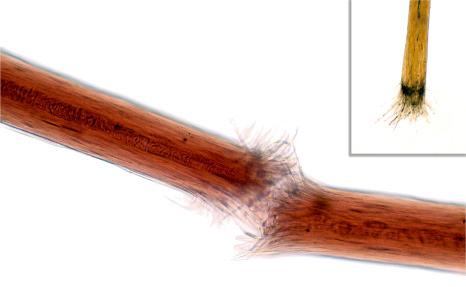
The hair samples obtained should be placed on a glass slide and fixed to the surface with transparent adhesive tape. As an alternative, the hairs can also be mounted as for routine microscopic sections with a coverslip. This method is excellent for obtaining photomicrographs, although air may obscure some details of the cuticle ( Fig. 22.2 ). The slide preparation must be done with great care, without exerting undue pressure, to avoid artifact.
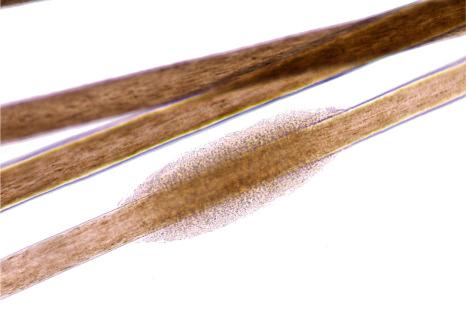
It is important to examine both the proximal and distal ends of the hair shaft because the more specific changes are usually found in the proximal segment. Polarized light microscopy must be used in cases of children with alopecia characterized by short and fragile hairs ( Fig. 22.3 ). This technique is particularly crucial in the differential diagnosis of trichothiodystrophy (TTD), as it shows the hair shafts with alternating light and dark transverse bands (tiger tail pattern). In loose anagen hair syndrome, special stains such as toluidine blue or elastic van Gieson must be performed to adequately visualize the internal root sheath.
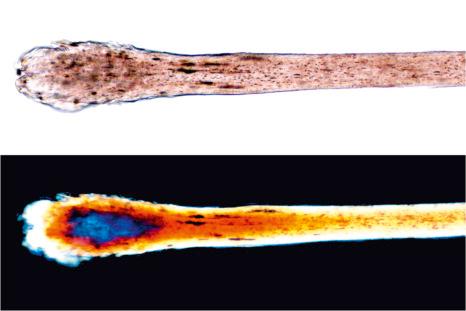
Additional examination with scanning electron microscopy allows a good evaluation of all the components of the hair shaft including the cuticle and cortex. With this method, tridimensional images may be obtained.
The hair shafts can be examined for irregularities, hair breakage, or extraneous matter. The hairs can also be examined under 20% potassium hydroxide and cultured in Sabouraud agar to rule out a fungal infection.
The hair tips should be examined to see whether they are tapered or broken. The distal segment is more prone to secondary changes due to wear and tear or secondary to hair shaft anomalies.
The hair bulbs present the following characteristics:
anagen bulb: pigment in bulb, dark keratogenous zone, medulla, inner root sheath, and outer root sheath,
telogen bulb: club-shaped, without hair shaft pigment, keratogenous zone, inner or outer root sheath ( Fig. 22.4 ),
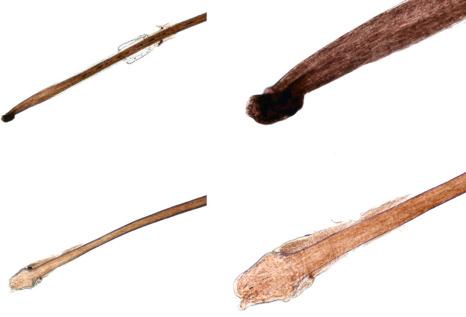
the rare hairs in catagen observed are vaguely similar to hairs in telogen with a sac of keratin and a short tail of clear semitransparent tissue.
The trichoscan may be considered as a noninvasive modification of the trichogram which combines epiluminescence microscopy with automatic digital image analysis for the measurement of human hair. It can be used in clinical studies to compare the different efficiency of various hair growth-promoting substances.
Dermoscopy is a technique that has recently been successful in the study of hair diseases. With the use of a dermatoscope, this noninvasive method enables identification of useful diagnostic structures for the majority of hair diseases of the scalp and identifies the best sites for a biopsy ( Table 22.1 ).
| Non-Scarring Alopecia | Trichoscopic characteristics 1-4 |
|---|---|
| Androgenetic alopecia | Hair shaft thickness heterogeneity more than 20 % Yellow dots Perifollicular brown discoloration or halo (peripilar sign) Increased proportion of vellus hairs Follicular units with only 1 emerging hair shaft |
| Telogen effluvium | Diagnosis of exclusion, limited diagnostic value Multiple short upright regrowing hairs Follicular units empty or with only 1 emerging hair shaft |
| Alopecia areata | Yellow dots and black dots Exclamation mark hairs, broken hairs, vellus hairs Active disease: black dots, exclamation mark hairs, broken hairs Disease severity and inactive disease: yellow dots, vellus hairs |
| Tinea capitis | Corkscrew hairs, comma hairs Black dots with scaling |
| Trichotillomania | Multiple hair shaft abnormalities with no significant changes in the perifollicular area Hairs broken at different lengths, short hairs with trichoptilosis, coiled hairs, exclamation mark hairs Black dots |
| Congenital triangular alopecia | Normal follicular openings with vellus hairs surrounded by normal terminal hair |
| Scarring alopecia | Trichoscopic characteristics 1-3 |
|---|---|
| General findings in scarring alopecia | Lack of black dots and yellow dots Milky red areas |
| Lichen planopilaris | Tubular perifollicular scaling Blue-grey dots with a target distribution Active disease: elongated linear blood vessels in concentric arrangement and violaceous inter or perifollicular violaceous areas Inactive end stage-disease: small, irregularly shaped, whitish areas lacking follicular openings |
| Frontal fibrosing alopecia | Lonely hairs, surrounded by areas of fibrosis Lack of follicular openings Perifollicular erythema and minor perifollicular scaling |
| Discoid lupus erythematosus | Large yellow-brownish dots Long-lasting disease: arborizing vessels Good prognostic factor: follicular red dots |
| Folliculitis decalvans | Hair tufts that contain 5 to 20 hair shafts Yellowish tubular perifollicular scaling Follicular pustules |
| Dissecting cellulitis | Early disease: empty follicular openings, black dots, yellow dots Advancing disease: yellow structureless areas and yellow dots with 3-dimensional structure imposed over dystrophic hair shafts End-stage fibrotic lesions: confluent ivory-white areas |
1 Mubki T, Rudnicka L, Olszewska M, Shapiro J.Evaluation and diagnosis of the hair loss patient: part II. Trichoscopic and laboratory evaluations.J Am Acad Dermatol. 2014;71(3):431.e1-431.e11.
2 Jain N, Doshi B, Khopkar U. Trichoscopy in alopecias: diagnosis simplified.Int J Trichology. 2013;5(4):170-8.
3 Tosti A, Torres F.Dermoscopy in the diagnosis of hair and scalp disorders.Actas Dermosifiliogr. 2009;100 Suppl 1:114-9.
4 Ferrándiz L, Moreno D, Peral F, Camacho FM. Tricoscopia. Piel. 2011;26(7):323-29
Scalp biopsy is a very valuable tool in the diagnosis of hair loss. Ideally, two deep punch biopsies 4 mm in diameter should be obtained for comparison from different sites: one should be taken from the affected area and the second from the periphery where there is healthy scalp. An alternative is to take the two biopsies from different involved areas (e.g., in cases of scarring alopecia). Sometimes a single biopsy is enough to make an accurate diagnosis, but this depends on the level of experience of the clinician and the pathologist. It is highly recommended to verify that the internal diameter of the punch which is to be used really measures 4 mm (12.6 mm 2 ), as this measure varies from one company to another. The biopsy is taken following the direction of the hair follicles with the intention of minimizing tangential sections. It should include epidermis, dermis, and a very generous amount of subcutaneous tissue. The obtained specimen must be delicately handled, avoiding any crushing by the forceps, and quickly placed in 10% neutral buffered formaldehyde.
The sections can be vertical, transversal (horizontal), or both, depending on the experience of the laboratory with one or the other particular section, with the type of alopecia being studied, and the number of biopsies taken.
For the transverse sections, the sample should be divided 2 mm away from the epidermis and serial sections obtained from both parts toward the surface and the deep layers of the specimen. In this way, the sections obtained from the upper portion will sequentially approach the surface epithelium and those derived from the lower portion will sequentially approach the deep dermis and subcutaneous fat ( Fig. 22.5 ). Afterwards, the basic stainings are performed with hematoxylin and eosin and electively with toluidine blue, periodic acid-Schiff (PAS), Masson trichrome, and elastic tissue stain. The best sections to evaluate terminal anagen hair follicles/vellus hair and hair follicles in anagen, catagen, and telogen are those obtained at the limit between the upper and lower segment of the hair follicle (at level of the bulge).
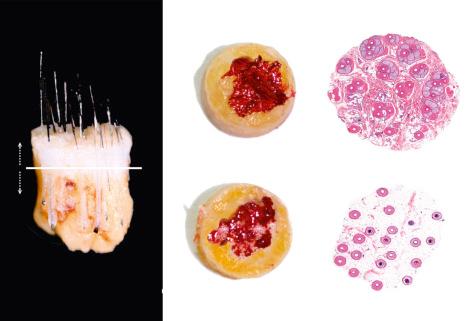
Although transverse sections of scalp skin have been studied for more than 100 years, it was not until 1984 that Headington carried out the first systematic studies of scalp biopsies using serial sections. This method represented a significant advance in the diagnosis and understanding of diseases of the hair. The Headington technique demonstrated that transverse sections of biopsies obtained with a 4-mm punch provided excellent histologic material for morphometric and quantitative analysis, including the different phases of the normal hair growth cycle. This technique has been modified over the years, and multiple horizontal sections throughout the sample are evaluated, enabling the pathologists to correctly evaluate most types of alopecia including chronic telogen effluvium, male androgenetic alopecia, alopecia areata, and the various types of scarring alopecia, and to perform digital image studies in cases of nonscarring alopecias. It is also a very useful method to evaluate the effects on the hairs after the administration of a given drug.
The biggest advantage of this type of technique is that all the hair follicles present in the biopsy may be counted and examined at different levels. An accurate count of all the hair follicles present in a specimen may be done by conventional microscopy or by computer-assisted techniques. Its principal limitation is the little representation of the dermal–epidermal junction ( Fig. 22.6 ).
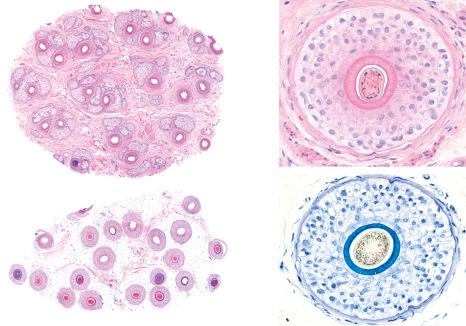
Vertical sections were exclusively used for many years and they provide a panoramic view from the epidermis to the hypodermis, more familiar to the general pathologist and to the dermatopathologist. These allow clear differentiation of all compartments of the skin, especially the dermal–epidermal junction and superficial dermis. This is particularly useful in the diagnosis of scarring alopecias which involve the epidermis and the interface such as discoid lupus erythematosus, folliculitis decalvans, and psoriasis ( Fig. 22.7 ). However, only very few hair follicles are visualized with vertical sections (at best 10–15% of the total in a single section), and often these are sectioned transversely or obliquely ( Fig. 22.8 ). It is not an adequate technique for quantitative studies or for establishing the ratios between the different phases of the hair follicles (anagen/telogen ratio, terminal/vellus hair ratio), hence its use is very limited in the diagnosis of androgenic-type alopecias and those of chronic telogen effluvium. It is universally accepted that both techniques present obvious advantages and disadvantages, and if two biopsies are available the best option is to use one for the transverse sections and the other for the vertical sections ( Fig. 22.9 ), hence using the second half of the latter one for complementary studies (cultures, immunofluorescence, electron microscopy).
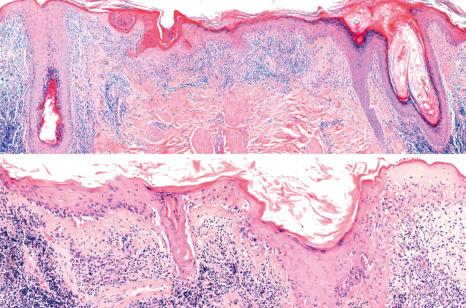
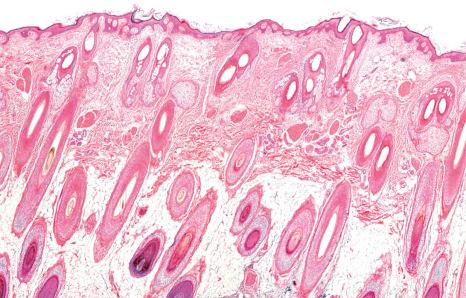
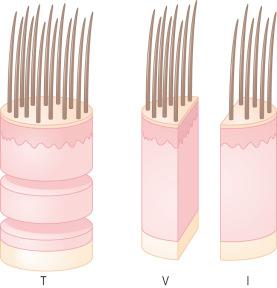
There are other known methods to interpret scalp biopsies such as the HoVert (horizontal and vertical) and Tyler techniques. In the former, the specimen is sectioned horizontally at a distance of 1 mm from the epidermal surface. The lower half is processed using horizontal sections and the upper part containing the epidermis is processed using vertical sections. In the Tyler technique, the specimen is divided vertically into two halves. One half is used for vertical sections and the other half for horizontal sections.
Regardless of the type of sections being chosen, it is important to remember that to reach a reliable histopathological diagnosis, it is of the utmost importance to carefully select and plan the site of the biopsy. Likewise, it is important to bear in mind that as the alopecia becomes more chronic, particularly in the scarring type, the findings in the biopsy will become less specific.
It is crucial that all quantifiable data are included in the histology report. This often allows for an accurate diagnosis when the pathological findings are correlated with the clinical information ( Box 22.1 ).
Total number of hair follicles in the biopsy (terminal + vellus, in anagen, catagen, and telogen)
Total number of hair follicles per square millimeter (total/12.6)
Number of terminal hair follicles
Number of vellus hairs (vellus + miniaturized hairs)
Number of undetermined follicles
Terminal:vellus hair ratio (T:V): terminal hair follicles / vellus
Number of terminal hair follicles in anagen
Number of terminal hair follicles in telogen
Number of terminal hair follicles in catagen
Telogen count: terminal telogen hairs (telogen + catagen) / terminal hair follicles.
Presence, type and localization of inflammatory cell infiltrate
Presence or absence of scar tissue
Presence or absence of pigmented casts
Even though the microscopic features, chemical composition, and molecular structure are very similar in different ethnic groups, significant differences in conformation, mechanical properties, and capacity to absorb water according to ethnic origin have been described. Especially important are the striking differences in hair density and relative proportion of hair follicles in anagen/telogen and terminal/vellus hairs in blacks, Asians, and Caucasians, which should be always taken into consideration when interpreting scalp biopsies ( Table 22.2 ).
| Characteristic | Asia | America | ||||
|---|---|---|---|---|---|---|
| Race | Taiwanese, n = 31 | Korean, n = 35 | Iranian, n = 30 | Caucasian, n = 22 | African American, n = 22 | |
| Author | Present study | Lee et al | Aslani | Whiting | Sperling | p -Value * |
| Age, mean ± SD | 37.0 ± 15.3 | 33.1 ± 10.0 | 35.5 ± 14.7 | 43 ± 3.5 | 31.7 ± 8.5 | .04 |
| Number of terminal hairs, mean ± SD | 20.5 ± 4.6 | 14.9 ± 3.2 | 34 ± 6.4 | 35 ± 2.1 | 18.4 ± 5.0 | <.001 |
| Number of vellus hairs, mean ± SD | 0.8 ± 1.0 | 1.1 ± 1.3 | 2.4 ± 1.2 | 5 ± 0.6 | 3.0 ± 2.1 | <.001 |
| Number of total hairs, mean ± SD | 21.3 ± 4.8 | 16.1 ± 3.6 | 36.3 ± 7.2 | 40 ± 2.2 | 21.5 ± 5.0 | <.001 |
| Number of follicular units, mean ± SD | 9.4 ± 1.9 | 7.8 ± 1.7 | ND | 14 ± 0.5 | ND | <.001 |
| Anagen: telogen ratio,% | 91.6 : 8.4 | 93.6 : 6.4 | 93.7 : 6.3 | 93.5 : 6.5 | 93.9 : 6.1 | .47 |
| Terminal: vellus ratio | 25.3 : 1 | 13.5 : 1 | 17.4 : 1 | 7 : 1 | 6.1 : 1 | <.001 |
| Density of hair follicles/mm 2 | 1.69 ± 0.4 | 1.2 ± 0.3 | 2.89 ± 0.6 | 3.1 ± 0.8 | 1.65 ± 0.4 | <.001 |
| Density of follicular units/mm 2 | 0.75 ± 0.2 | 0.62 ± 0.1 | ND | 1.11 ± 0.04 | ND | <.001 |
* Ko J.H., Huang Y.H., Kuo T.T. Hair counts from normal scalp biopsy in Taiwan. Dermatol Surg. 2012. 38, Sep;1516-20.
Embryologically, each follicle is composed of epithelial and mesenchymal components. Epithelial invaginations (placodes) derive from the fetal epidermis and project downward at regularly spaced intervals, proliferating under the influence of the underlying connective tissue cells which form the mesenchymal condensation of the hair peg. This occurs around the 10th week of gestation ( Fig. 22.10 ). This dermal condensate will eventually mature into the dermal papilla. The hair follicle does not develop in the absence of this mesenchymal influence. Afterwards, the hair follicle elongates into a lace of epithelial cells and the deeper component forms the bulbous and the matrix cells, which give origin to the hair shaft and inner root sheath. The outer root sheath forms three bulges. The upper one will give origin, in the follicles located in the anogenital region, axillae, areolae, periumbilical region, eyelids, and external ear canals, to the apocrine glands. The middle bulge will give origin to the sebaceous gland. The lowermost bulge corresponds to the location of the epithelial stem cells. This is also the attachment site of the arrector pili muscle.
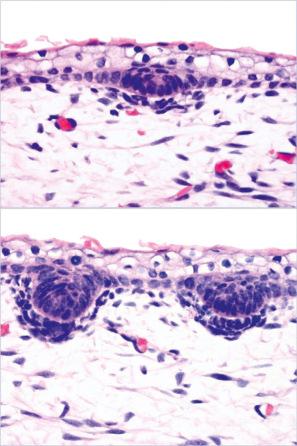
The first follicles develop in the scalp, and from there they extend downwards to populate the rest of the body. Initially, they are observed as fine thin nonpigmented hairs, known as lanugo hair. These fall off at the end of the gestation period, although some remain until after birth. The majority are replaced by terminal hairs, present in the scalp, eyelashes, and eyebrows of the newborn and vellus hairs on the rest of the body. No new hair follicles form after birth. At puberty the vellus hairs present on genital skin and axilla in females and on the legs, torso, and the chin in males transform into terminal hairs under the influence of sexual hormones. Paradoxically, in individuals with androgenic alopecia the terminal hairs in the scalp transform into miniaturized hair follicles in those individuals who are susceptible. Hair follicles will eventually be found on all body surfaces except for the palms, soles, and mucous membranes.
The genes and molecules that participate in the development of the hair follicle have been extensively studied. Different positive and negative regulators which are expressed at variable time during the development of hair follicles have been identified. Some of the most relevant of these regulators are described in Table 22.3 .
| Hair Follicle Morphogenesis Step | Gene Product |
|---|---|
| Outer root sheath | Sox9, Shh/Smo |
| Inner root sheath | GATA3 , Cutl1 (CDP) , BMPs/BMPR1a, Shh/Smo, Notch1/Jagged/ Delta/RBP-Jk for IRS fate maintenance |
| Hair shaft | B-catenin , Wnt's and Lef-1, VDR (Vitamin D receptor)(only in postnatal hair cycle), BMPs/BMPR1a, Shh/Smo, msx1 and 2, FoxN1/Nude, HoxC13, Notch1/Jagged/Delta/ RBP-Jk (only in postnatal hair cycle) |
| Polarity, shaping and bending | Shh (asymmetric, polarized expression pattern in hair matrix), |
| Igfbp5, Eda A1, Krox-20, FoxE1, Runx3, Sox18 | |
| Innervation | B-catenin , NCAM |
| Pigmentation | FoxN1/Nude , SCF/c-kit, Notch |
| Bulge region/hair stem cell maintenance | BMPs/BMPR1a, Lhx2, Sox9, NFATc1, p63, |
| Tcf3 (w/o Wnt activity), Rac1, integrins a3b1 and a6b4 |
To correctly evaluate a scalp biopsy, it is important for the pathologist to be well versed not only in the histology of the different types of alopecias but also in the complex and changing anatomy of the healthy hair follicle and its features in both vertical and horizontal sections. There are important morphological variations related to the normal follicular cycle and to the miniaturization of the terminal follicles in susceptible individuals. In the following section, these aspects will be individually reviewed.
Horizontal sections of the upper segment of the hair follicle show that hair follicles in the scalp are grouped, forming anatomic structures known as follicular units, which are composed of terminal and vellus hairs, sebaceous glands, and arrector pili muscles. The distribution of hair follicles in follicular units is better appreciated at the level of the infundibulum and isthmus. The connective tissue surrounding the outer root sheath tends to condense around discrete units comprising three to six hair follicles, one or two of which represent vellus hairs ( Fig. 22.11 and also see Fig. 22.6 ).
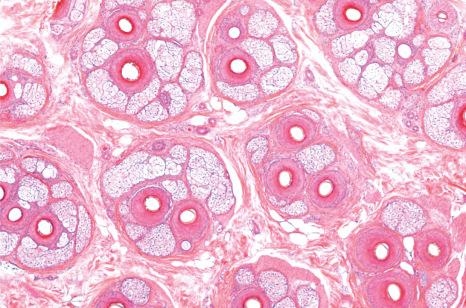
Terminal hair follicles are easy to recognize in horizontal sections because they are much larger than vellus hairs ( Fig. 22.12 ). These follicles are thick, pigmented, and usually descend to the subcutaneous fat (see Fig. 22.8 ). They contain a hair shaft, the diameter of which is greater than the thickness of the inner root sheath, and generally measures in excess of 0.06 mm ( Fig. 22.13 and also see Fig. 22.6 ).
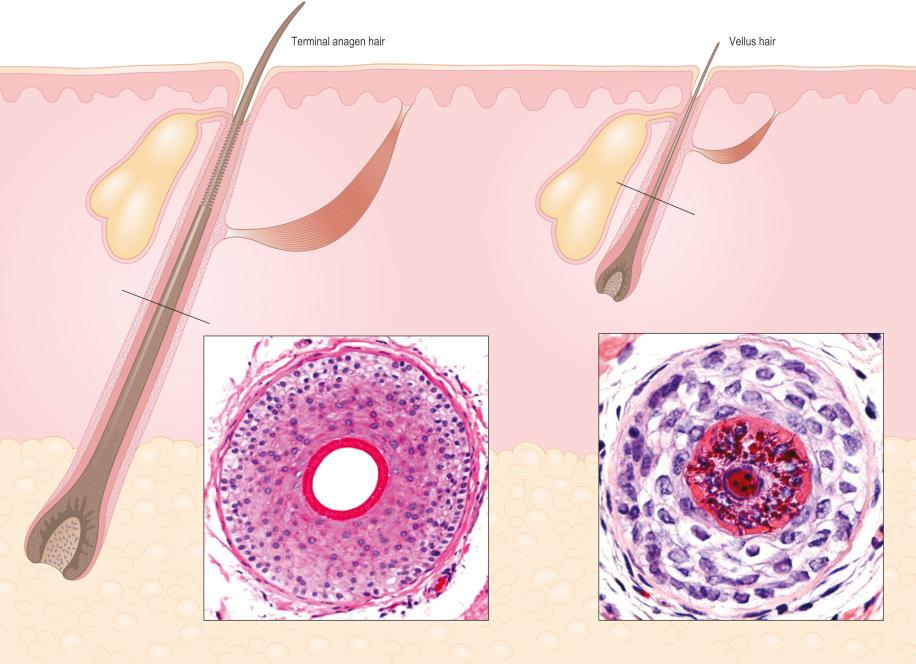
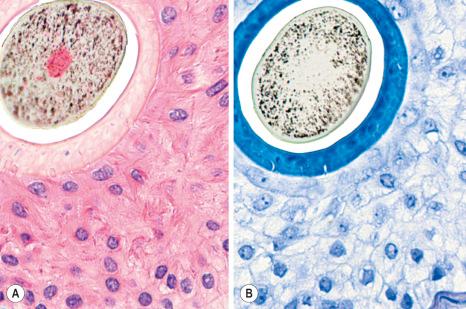
True vellus hairs are thin, short, and nonpigmented, and are characterized by a hair bulb that only extends to the upper or mid-reticular dermis ( Fig. 22.14 ). The arrector pili muscle is usually undetected. The hair shaft diameter is equal to or less than the thickness of the inner root sheath ( Fig. 22.15 ). It is typically less than 0.03 mm.
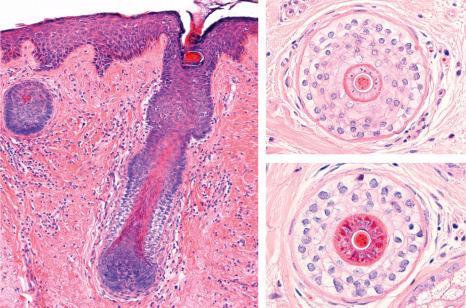
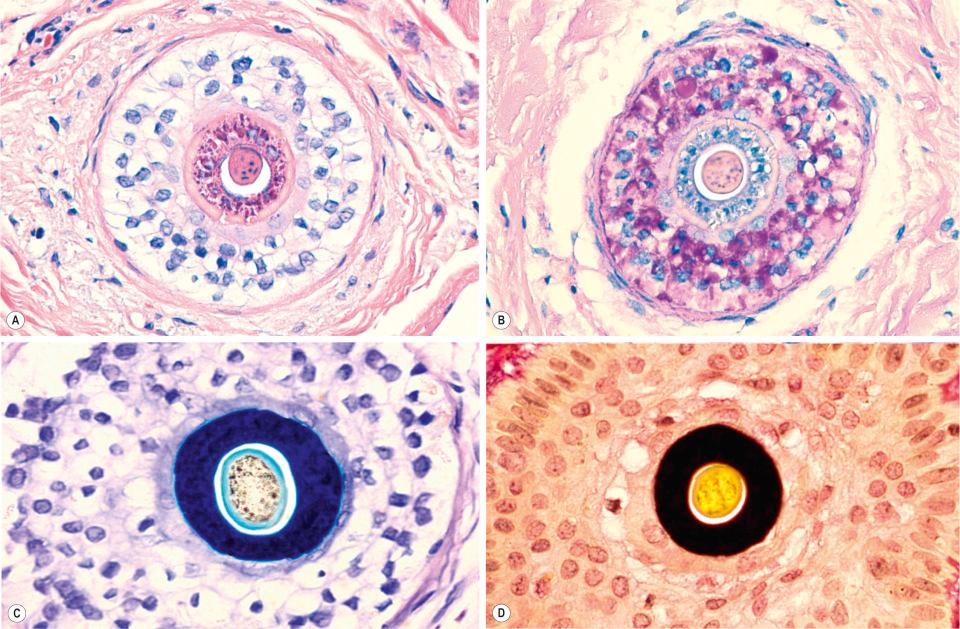
Vellus-like hairs (miniaturized hairs) are very similar to vellus hairs. They correspond to terminal hair follicles that have miniaturized owing to the effect of androgens. They may be very difficult to differentiate from true vellus hairs, except for the fact that the miniaturized follicles leave a trail of stellate collapsed fibrous tissue, the follicular stellae. In a scalp biopsy, when reference is made to vellus hairs without qualifying its origin, it refers by convention to both miniaturized and to true vellus hairs.
Indeterminate hairs have an intermediate morphology between that of terminal and vellus hairs and are considered an intermediate step in the process of miniaturization. The diameter of an indeterminate hair shaft is between 0.03 and 0.06 mm. There is no clear consensus as to which group of hair follicles do indeterminate follicles belong to. We concur with the suggestion of some authors who recommend assigning half of these hairs to terminal hair follicles and the other half to vellus hairs.
The hair shaft and the inner root sheath are easily identified in vertical and horizontal sections at the level of the stem, immediately below the bulge, with conventional staining procedures including hematoxylin and eosin, toluidine blue, and elastic stains ( Fig. 22.15 and see Fig. 22.13 ). The ratio between terminal and vellus hairs is approximately 7 : 1. Distinguishing between terminal and vellus hair follicles is critical for the diagnosis of androgenetic and temporal triangular alopecia. A ratio of 4 : 1 or less is suggestive of androgenetic alopecia. By definition, hair follicles and vellus hairs do not reach the subcutaneous tissue; therefore, to determine the final number of hair follicles and in particular vellus hair, superficial sections must be done at the level of the isthmus. For this reason, the quantification of follicles in deep and superficial sections is different. Superficial sections may reveal five to six more follicles than those counted in deep sections. As previously mentioned, the ratio of terminal follicles to vellus hairs may vary between different ethnic groups ( Table 22.2 ). It is important to bear in mind that the hair shaft is frequently lost during the biopsy process. In these cases, its size may be extrapolated from the diameter of the empty space delimited by the inner root sheath.
The hair follicle can be anatomically and functionally divided into two distinct segments. Differences between these two elements are explained by the fact that the upper portion of the hair follicle is very stable and not affected by maturation and shedding of the hair. The lower portion of the hair follicle is actively involved in hair growth and undergoes considerable morphological change according to its stage in the hair cycle.
The upper segment of the hair follicle consists of the follicular ostium, the infundibulum, and the isthmus ( Fig. 22.16 ). The ostium is the physical orifice through which hair stems usually emerge in groups of two or three. The loss of it is clinically observed in scarring alopecias. The infundibulum extends from the ostium downwards to the opening of the sebaceous gland duct. It is cone shaped, its walls formed by the epidermis, and normally, around it there is mild concentric fibrosis and an inflammatory lymphocyte infiltrate, particularly seen in people of African descent. This phenomenon may cause confusion when evaluating inflammatory scarring alopecias ( Fig. 22.17 ).
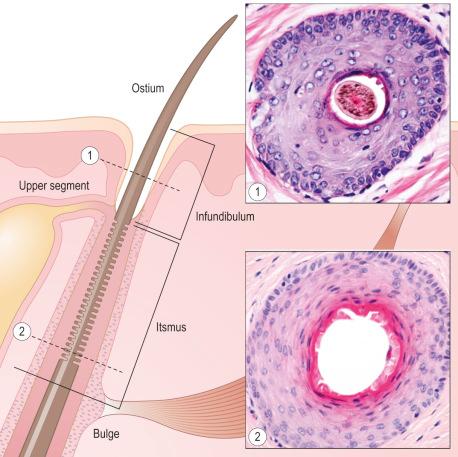
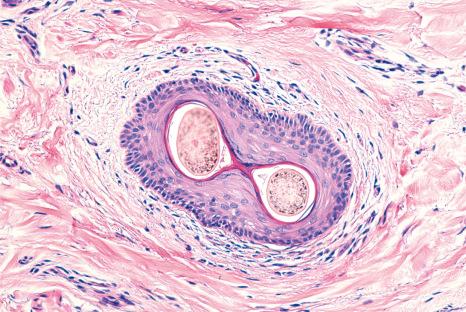
The isthmus continues from the opening of the sebaceous gland duct to the site of attachment of the arrector pili muscle at the hair bulge ( Fig. 22.18 ). The arrector pili muscle attaches to the bulge area through elastic tendons and extends to its upper attachment in the adjacent papillary dermis.
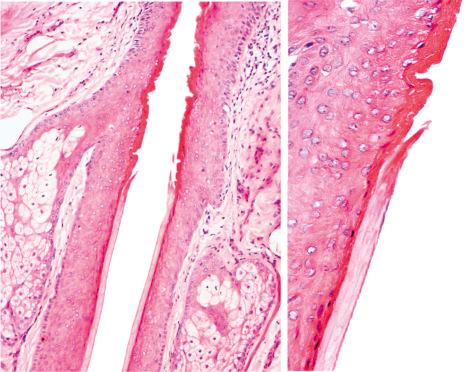
The lower segment extends from the arrector pili insertion to the lower part of the hair bulb and has two components: the stem (suprabulbar zone) that extends from the arrector pili insertion to the Adamson fringe and the lower portion called the bulb ( Figs 22.19 and 22.20 ). In a hair follicle in anagen, the stem is the longest structure in the hair follicle with a clearly differentiated internal and external radicular sheath clearly ( Fig. 22.21 ). The bulb comprises the matrix cells and the basal melanocytes that surround the dermal papilla ( Fig. 22.22 ).
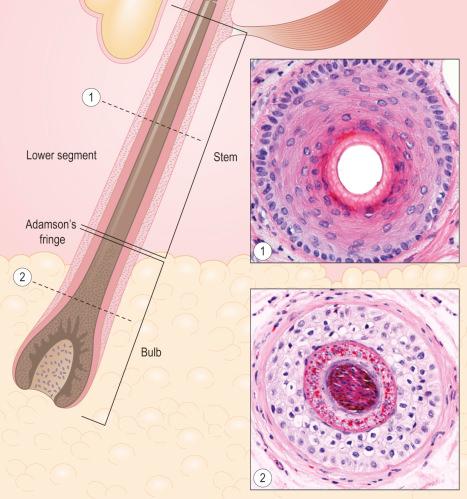
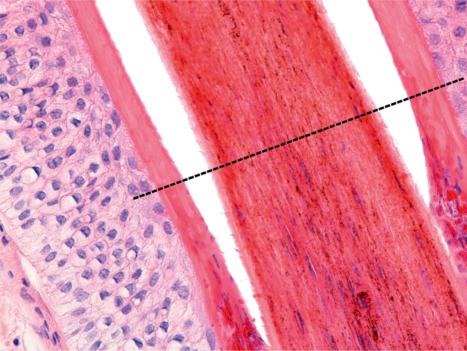
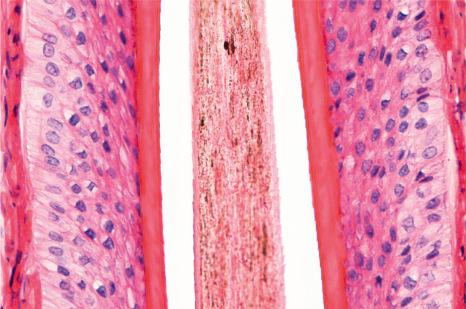
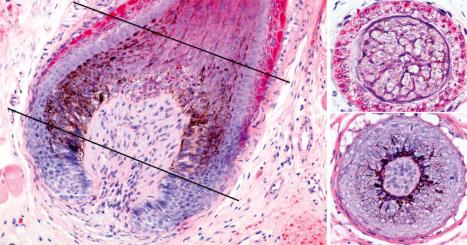
A hair shaft is composed of three layers: the medulla, the cortex, and the cuticle. The medulla, which represents the central region of the hair shaft, is not consistently present in humans, but it is often an important component of hair in other animals ( Fig. 22.23 ). The cortex is the thickest layer and is responsible for the strength of the shaft. It is composed of intermediate filaments of hard keratin that are arranged in microfibrils, which intertwine to form cable-like structures called macrofibrils. The cuticle, which constitutes the outer part of the shaft, is responsible for the resistance to the wear and tear produced by the environment. It consists of scales orientated at right angles to the epidermis. These interlock with the cuticle of the internal root sheath maintaining integrity and in the bulbar zone appears as a single layer ( Fig. 22.24 and see Fig. 22.21 ). The linear or curved shape of the hair is determined by the curved or linear shape of the internal radicular sheath. In horizontal sections, the hair in individuals of African descent is curved, elliptical, and eccentrically located within the follicular channel. In Caucasian individuals the hair is circular and centrally located within the follicular channel. In horizontal sections of a terminal anagen hair follicle, different layers can be identified in the suprabulbar area. From the center to the periphery these comprise:
Hair shaft (including the medulla, the cortex, and the cuticle of the hair),
Inner root sheath (including the cuticular layer of the inner root sheath, Huxley layer, Henle layer, and companion layer),
Outer root sheath,
Vitreous and external fibrous layer (perifollicular connective tissue sheath) ( Fig. 22.24 ).
These layers change noticeably depending on the level of the microscopic section. The cuticle of the hair shaft and all layers of the internal root sheath at the bulb level undergo trichohyaline keratinization. At the bulge, the inner root sheath starts to disappear and in the isthmus is replaced with trichilemmal keratin derived from the external root sheath (see Fig. 22.18 ).
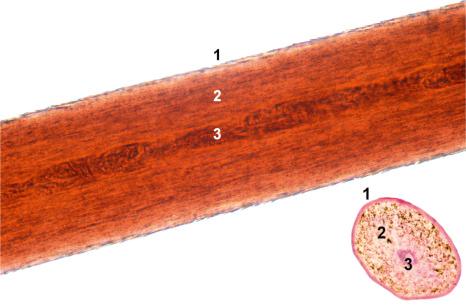
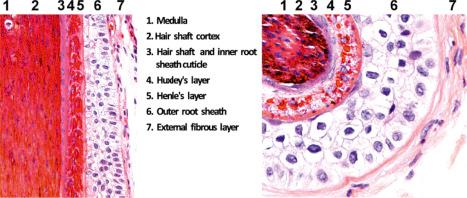
The external root sheath is continuous with the epidermis at the infundibulum and where it forms a granular layer with a basket weave arrangement of the epidermal keratin (see Fig. 22.17 ). Toward the bulb, the cells of the outer root sheath cells contain abundant glycogen ( Fig. 22.21 and see Fig. 22.24 ).
The hair growth cycle, whether terminal or vellus, is divided into three stages: active growth (anagen), involution (catagen), a period of rest (telogen), and, as an extension of this last stage, two additional stages: hair shaft-extrusion (exogen) and empty hair follicle (kenogen) ( Fig. 22.25 ). The duration of the anagen phase determines the length of the hair stem. Human beings differ from other mammals in that these stages occur continuously rather than synchronously. There is no periodic change of the hair covering the body. The duration and relative proportion of each stage is variable: anagen 2–7 years (85–100%), catagen 2–3 weeks (0–1%), and telogen 100 days (0–15%). The cycles of miniaturized hair follicles and vellus hairs cycles are much faster, thus shortening the anagen phase.
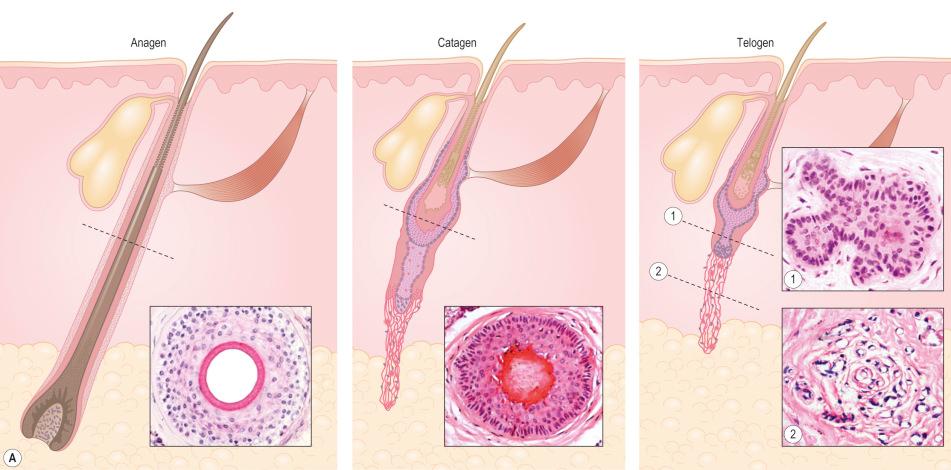
The interaction of numerous growth factors, cytokines, hormones, neurotransmitters, and their receptors are important in the development and cycling of normal hair follicles. It appears that the driving force of cycling, the ‘hair cycle clock’, is located in the hair follicle itself, in the immediate niche and in the dermal microenvironment. However, no single growth factor appears to exert ultimate control over these processes.
Anagen lasts from 2 to 7 years and is characterized by continuous growth, giving origin to a long and pigmented pilar stem, which is easily visible. It is the phase that determines the length of the hair and the phase that varies the most depending on the body location. Morphologically, it corresponds to the already mentioned terminal hair follicles deeply situated in the subcutaneous fat (see Fig. 22.19 ). The pilar bulb of the follicles in anagen shows abundant melanin production and intense mitotic activity, resulting in the hair growing approximately 1.0 cm per month. At any particular moment, between 85% and 100% of the hair follicles are in anagen. As this is the phase with the highest mitotic activity, melanogenesis, and DNA synthesis, it is the most vulnerable to hormonal changes, drugs, and different toxins.
Pigmentation of the hair only occurs in anagen, and it is induced by interactions between bulbar melanocytes, keratinocytes, and dermal papilla fibroblasts (hair follicle pigmentary unit) (see Fig. 22.22 ). The coupling of hair follicle melanogenesis to the anagen phase distinguishes follicular melanogenesis from the continuous melanogenesis of the epidermis. Cyclic reconstruction of the hair follicle pigmentary unit occurs optimally during only the first 10 hair cycles, i.e., until approximately 40 years of age. It is not clear if hair graying is a consequence of functional loss, or a selective melanocyte depletion of human hair.
Catagen precedes telogen and during this phase, the inferior segment of the follicle undergoes massive apoptosis, reducing its size. It is the shortest phase and lasts from 2 to 3 weeks. Only 1% to 2% of the follicles are in catagen, and it is rare to find them in normal scalp biopsies. Horizontal sections are characterized by diffuse apoptosis and an absence of mitotic and pigmentary activity. Apoptotic cells have intensely eosinophilic cytoplasm and have a dark pyknotic nucleus ( Figs 22.26 and 22.27 ). As the follicle retracts, the vitreous membrane collapses and appears thickened and corrugated ( Fig. 22.28 ). It is important not to confuse this phenomenon with the thickening of the basal membrane observed in discoid lupus. The inner root sheath disappears and the outer root sheath appears morphologically similar to the epithelium of the isthmus, surrounding a club-shaped hair shaft and keratinizing in a trichilemmal manner ( Fig. 22.29 ). Catagen follicles are frequent in trichotillomania.
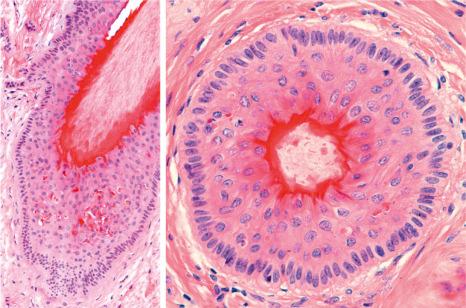
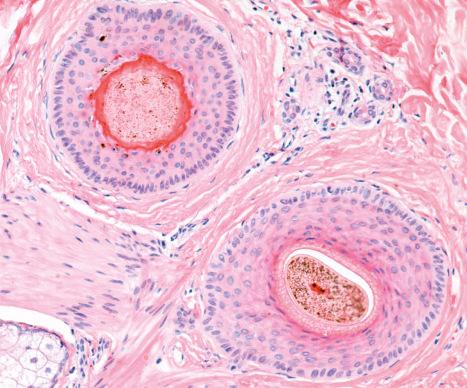
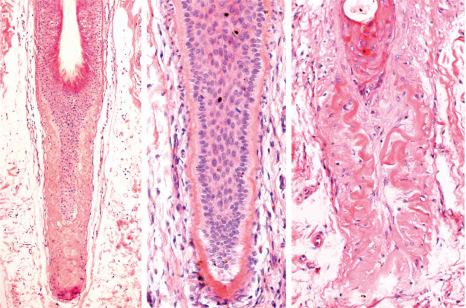
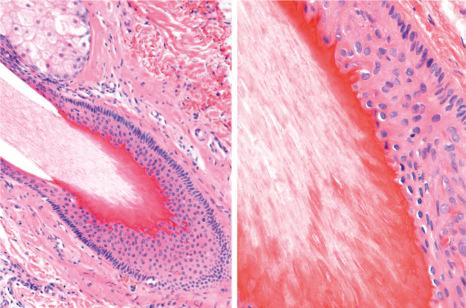
Because of the brevity of the catagen phase which quickly follows the telogen phase, for quantifying purposes both the catagen and telogen follicles are counted together. Telogen lasts 100 days. Approximately 10–15% of the total number of hairs are in telogen phase at any given time and around 100 telogen hairs are shed per day. A hair follicle in telogen represents the final stage of involution of the lower segment. The hair papilla is present under the area of insertion of the arrector pili muscle and in a horizontal section appears as an aggregate of basaloid cells (the secondary germ: telogen germinal unit) ( Figs 22.30 and 22.31 ). In the past, it was thought that the hair follicle stem cells were located in the telogen germinal unit. However, true stem cells are located in the bulge, in the insertion point of the arrector pili muscle; these cells are responsible for regenerating not only hair follicles but also sebaceous glands and epidermis ( Fig. 22.32 ). In the human hair follicle, the bulge is rarely visible, thus its detection requires the use of immunohistochemistry (cytokeratin 15). Loss of bulge stem cells leads to the cicatricial types of alopecia.
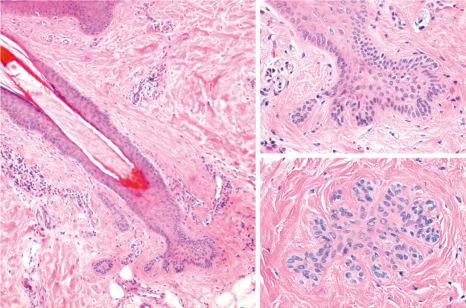
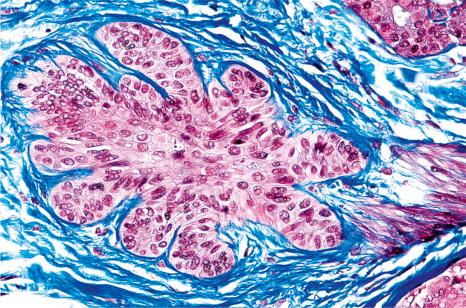
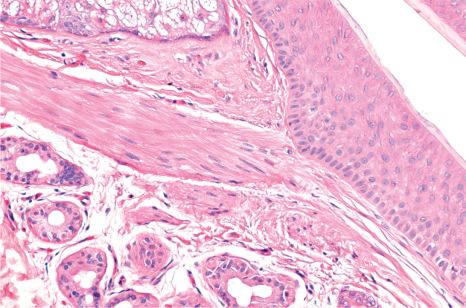
The lower segment of the hair follicle involutes completely, leaving only a structure called a follicular stella (follicular streamer, fibrous streamer), which indicates the position in which the retracted follicle was formerly located ( Fig. 22.33 ). The follicular stella is not specific of the telogen phase as it is also observed as a consequence of the miniaturization of the terminal hair follicles in androgenetic alopecia. These follicular stella as opposed to those found in scarring alopecias are not birefringent under polarized light ( Fig. 22.34 ).
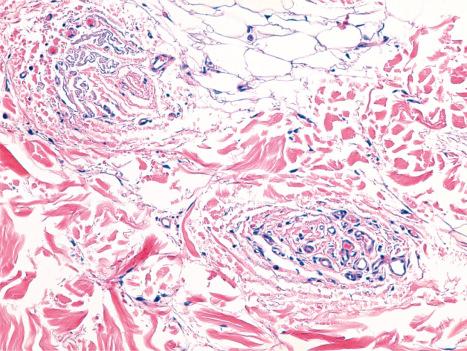
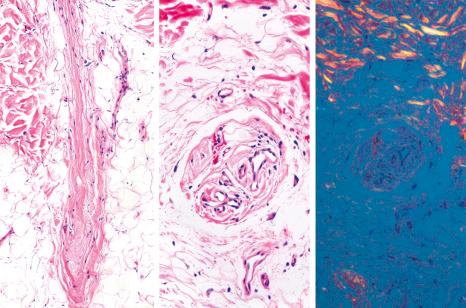
Two other phases are considered final components of the telogen stage:
Exogen (teloptosis) represents a telogen club which has lost the adhesion between cells of the club hair and those of its epithelial envelope, apparently by a proteolytic mechanism activating an active shedding process. This corresponds to the 100 hairs that are lost daily.
Kenogen refers to an empty follicle after the follicle in telogen has been shed. Follicles in exogen and kenogen are not easy to classify histologically.
Hair follicles also contain sebaceous glands that, with their secretion, lubricate the hair channel and skin surface. They are numerous and are easily identified in sections at the superior segment level. An early phenomenon in scarring alopecias is the loss of sebaceous glands. Apocrine glands are also associated with hair follicles in specific areas such as axillae, genital zone, medial abdomen, and areola.
The hair follicle immune system has distinctive configurations that maintain an area of relative immune privilege in the anagen stage of hair follicle cycle. The epithelium of the proximal hair follicle (the inner root sheath and hair matrix) is characterized by very low level of expression of major histocompatibility complex class Ia antigens, local production of immunosuppressive agents (transforming growth factor [TGF]-beta 1, alpha-melanocyte-stimulating hormone), and inhibition of natural killer (NK) cell activities. A collapse of this immune privilege is likely to play an important role in the pathogenesis of alopecia areata and possibly in some scarring alopecias.
Classification of alopecia is often difficult, both from a clinical perspective and in terms of etiology. Commonly, the cause cannot be identified, and there is considerable clinical and histologic overlap in the different types of alopecia. Many classifications have been proposed, and the most widely accepted divides alopecia into those that are patterned and those that diffusely involve the scalp and into cicatricial and noncicatricial (scarring and nonscarring) variants. Nonscarring alopecia is reversible whereas scarring alopecia is permanent. The follicular loss in the latter may result from the scarring process or develop independently.
The main problem with this classification is that there is a great degree of overlap, and clear-cut distinction is frequently not possible. In addition, some variants of alopecia (e.g., alopecia areata, trichotillomania, and traction alopecia) have a biphasic pattern: they are initially nonscarring but may become permanent (scarring) with time.
Scarring alopecias are classified into primary and secondary variants. Primary scarring alopecias are those in which the hair follicle is principally involved, as occurs in lichen planopilaris and lupus erythematosus. In the other variants, the hair follicle is not the main target of the inflammatory process and is destroyed as a secondary phenomenon. Examples of the latter include physical causes such as irradiation, infiltration of the scalp by tumor, inflammatory diseases including morphea, and infectious processes as may occur with fungi.
Androgenetic alopecia is also known as common baldness and male and female pattern hair loss. It is caused by androgens in genetically susceptible men, the role of androgens being less clear in women. Typically, there is progressive miniaturization of hairs in the scalp between the ages of 12 and 40 years.
Androgens are the main regulator of normal human hair growth. After puberty, they promote transformation of vellus hair follicles into large pigmented terminal hairs. However, androgens may also reverse this process, resulting in the gradual replacement of terminal hairs with vellus hairs and the onset of androgenetic alopecia.
Androgenetic alopecia is a very common disorder and is the most frequent type of hair loss in adults, affecting at least 50% of the male population by the age of 50, and about 40% of the female population by the age of 70. The prevalence of vertex and full-blown androgenetic alopecia increases with age in males between 40 and 70 years, but the proportion of males with disease restricted to the frontal region remains fairly constant.
Patients with androgenetic alopecia usually have a familial history of baldness. The absence of such a history reduces the risk but does not exclude the possibility of developing the condition. Rarely, it is associated with hyperandrogenism, and this is accompanied by other manifestations of excess androgens.
In males, the condition usually starts early after puberty, mainly affecting the crown, vertex, frontal, central, and temporal areas of the scalp. There is usually no involvement of the occipital and lower parietal regions ( Fig. 22.35 ). Some cases present in adolescence and in childhood, usually associated with a strong genetic predisposition. It has been proposed that patients who develop hair loss before the end of the third decade may have a higher risk of coronary artery disease than nonaffected males. However, other studies have restricted such association to alopecia localized to the vertex and some authors have totally discarded this association.
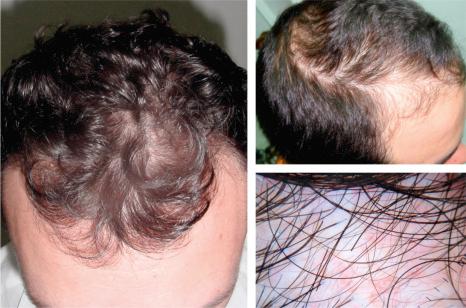
An association with insulin resistance-linked diseases and with higher mortality for diabetes and cardiovascular disease has been noted in older patients with androgenetic alopecia.
The condition also appears to be a risk factor for prostate cancer and benign prostatic hyperplasia.
Androgenetic alopecia is more frequent in whites than in black men. Association of androgenetic alopecia with smoking has been observed among Asian men. The frequency appears to be increasing in this ethnic group. Androgenetic alopecia appears to be more common in males with X-linked recessive ichthyosis. Male-pattern baldness has been also associated with a susceptibility locus at chromosome 20p11.22. Some patients may also have associated trichodynia.
In females, the hair loss is patterned and characterized by progressive thinning over the frontal/parietal scalp, retention of the frontal hairline, and the presence of miniaturized hairs. The process is noted as widening of the central part of the scalp ( Fig. 22.36 ). Female pattern hair loss is much less frequent than in men, and complete baldness very rarely ensues. The hair loss often starts around the onset of the menopause, although occasionally it develops much earlier ( Fig. 22.37 ). Female pattern hair loss has been associated with hyperprolactinemia.
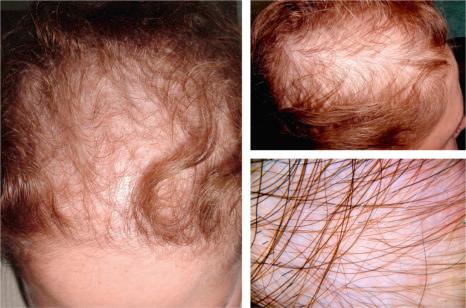
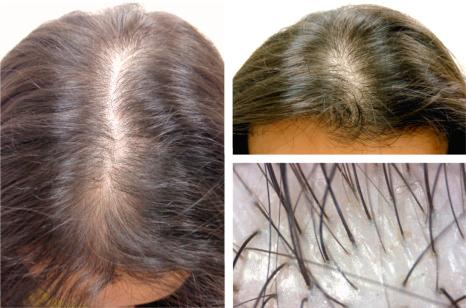
The two patterns of hair loss in androgenetic alopecia are sometimes known as Hamilton-Norwood ‘male pattern’ and Ludwig ‘female pattern’ ( Fig. 22.38 ). However, there is considerable overlap. Some women present with male pattern and vice versa. Korean men tend to have a more ‘female pattern’ of hair thinning than Caucasians. These types of inverse presentation do not define the hormonal state of the individual; a woman with a masculine pattern of alopecia does not necessarily present with hyperandrogenism.
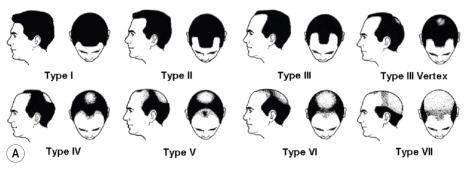
The different clinical presentations and the fact that the occipital scalp is generally respected is a consequence of the different embryological origins of the dermis in the different areas of the scalp. The dermis of the frontal/parietal scalp is of neural crest origin, whereas the dermis of the occipital scalp is of mesodermal origin.
Dermoscopy and videodermoscopy of hair and scalp show important differences in hair shaft diameter, with a mixture of indeterminate and terminal hairs. Its use has enabled both the clinical diagnosis and the monitoring of the response to treatment to be more accurate. The site most affected by the alopecia is easily located and consequently will be the best site to biopsy (see Figs 22.35–22.37 ).
Men suffering from androgenetic alopecia do not usually require laboratory investigations. The decision to perform laboratory tests in affected females depends on a variety of factors including family history, clinical presentation, evolution, and age at onset of the disease. A woman with menstrual irregularities, a history of infertility, polycystic ovaries, or physical signs suggesting hyperandrogenism (hirsutism, cystic acne unresponsive to treatment, acanthosis nigricans, virilization, or galactorrhea) should have further investigations including free and total testosterone levels. If these are high the source should be determined, especially with respect to the presence of an ovarian tumor or adrenal hyperplasia. In women with androgenetic alopecia without a family history or physical signs suggestive of hyperandrogenism, it is not usually necessary to perform any laboratory tests.
In androgenetic alopecia, a gentle hair pull is normal. Only a few hairs are obtained, and these are all in telogen phase. Hair pluck can give misleading results due to an apparent higher count of hair in telogen in the affected areas. This occurs because, in the early stages, hair follicles more frequently enter telogen as a result of shortening of the anagen phase. Confusion with telogen effluvium is possible but distinction is easy, based on the fact that telogen effluvium is generalized and androgenetic alopecia is localized.
Androgenetic alopecia results from a progressive decrease in the size of hair follicles and their transformation into vellus forms ( Fig. 22.39 and see Figs 22.12 and 22.14 ). However, it has also been observed that this miniaturization may occur suddenly within only a few cycles. This phenomenon is the direct result of 5α-reductase type II activity, which is mainly found in the external root sheath and the hair bulb papilla. The enzyme converts testosterone into dihydrotestosterone, which has a great affinity for the androgen receptors in the outer root sheath and follicular papilla of the hair follicle. The hormone receptor complex activates the genes responsible for the gradual transformation of large terminal hairs into miniaturized hair follicles. Young women and men with this condition have higher levels of 5α-reductase and androgen receptor in frontal hair follicles when compared with occipital follicles. Finasteride inhibits 5α-reductase type-2 isozyme, lowering the levels of dihydrotestosterone and promoting hair growth in men.
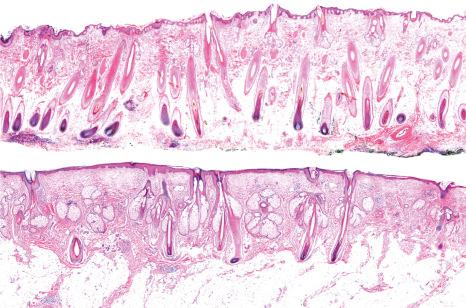
However, the role of androgens in the female pattern hair loss variant is not fully established. Scalp hair loss is a feature of hyperandrogenism in females but many women with female pattern hair loss have no other clinical or biochemical evidence of androgen excess. Female pattern hair loss is probably a multifactorial, genetically determined trait and it is possible that both androgen-dependent and androgen-independent mechanisms contribute to the phenotype. Other enzymes that modulate the effect of the androgens and estrogens and serve as protecting factors against androgenetic alopecia are cytochrome p450 aromatase and 17β-hydroxysteroid dehydrogenase. These lead to increase in the level of local estrogen in the hair follicle with variations in relation to sex, age, and location of the hair follicles.
In both, male and female pattern hair loss there is a decline in anagen duration, increase in the percentage of hair follicles in telogen, and a higher frequency and prolongation of the kenogen phase, particularly in cases of high miniaturization of the hair follicles. It would seem that the telogen hair follicle follows an alternative route, one not followed by a new early anagen phase but rather remaining for a prolonged period as an empty follicle. The final result is nonpigmented hair shafts, which progressively become thinner and smaller, and this finally results in empty follicles without stems (teloptosis). Some follicles could fade away and be replaced by fibrous tracts.
For the microscopic study of androgenetic alopecia, two 4-mm punch biopsies should be obtained: a control from healthy scalp in the occipital region and the other from the affected area. Both biopsies must be sectioned horizontally from the lower part of the infundibulum for comparative quantification purposes. The ratio between terminal and vellus hairs is approximately 7 : 1. A ratio of 4 : 1 or less is suggestive of androgenetic alopecia.
The histologic features are different in the early and late stages of the disease. Terminal, indeterminate, and vellus hairs should be counted. It is easier to appreciate the miniaturization of hair follicles and dropping out of follicular units when a comparison is made with the biopsy of normal scalp taken from the occipital area ( Fig. 22.40 ). This process does not present in a uniform manner as initially it can be focal and may even only affect some of the follicles within a follicular unit ( Fig. 22.41 ). A toluidine blue stain is particularly useful to highlight the outer and inner root sheaths in contrast to the pale staining of the hair shaft ( Fig. 22.42 and see Fig. 22.15 ).
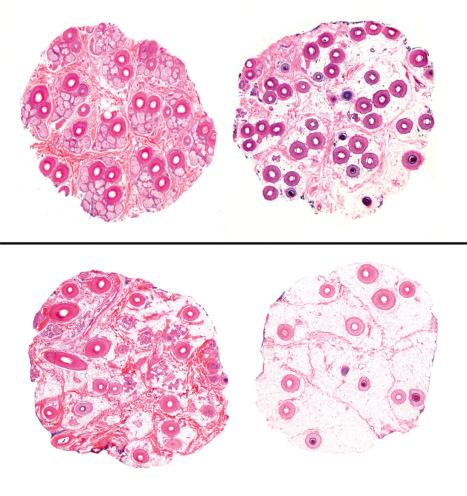
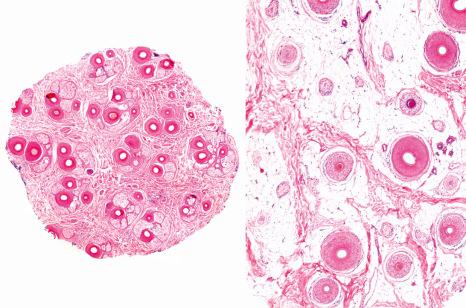
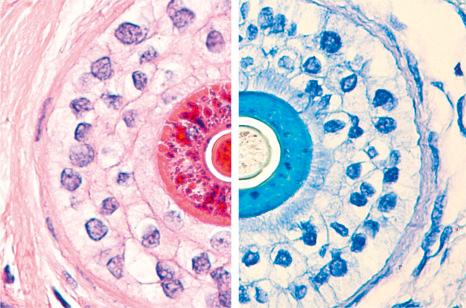
Histologically, terminal hairs progressively transform to vellus hairs ( Figs 22.43 and 22.44 ). There is a decrease in the size of the dermal papilla and bulb. The diameter of the hair shaft also decreases and varies noticeably from one follicle to another. This histologic feature is closely related to the miniaturization observed clinically ( Fig. 22.45 ).
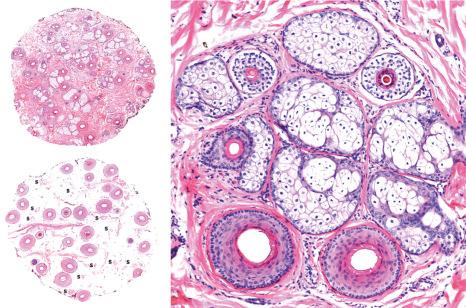
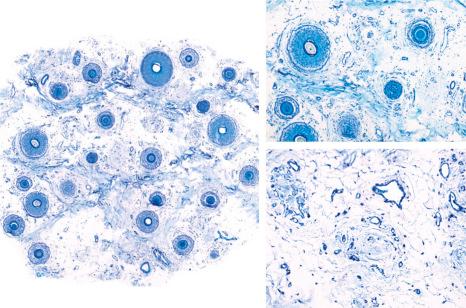
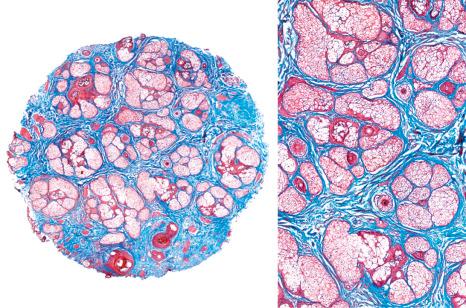
Although the total hair count is normal, it will appear reduced if the count is taken at the junction of the dermis and subcutaneous fat, since by definition terminal hairs are diminished in number. Even though these changes may also be seen in vertical sections (see Fig. 22.39 ), they are more difficult to interpret and quantify.
Along with these changes, there is a reduction in the duration of the hair follicle cycle at the expense of the anagen phase. Therefore, in patients with evolving or fully established androgenetic alopecia, it is very common to find an increment in the number of catagen and telogen follicles in the miniaturized follicles component. The histologic picture of the female variant is identical.
A mild to moderate T lymphocytic inflammatory cell infiltrate frequently surrounds the upper third of the hair follicle, associated with discrete perifollicular concentric fibrosis particularly in patients of African descent ( Fig. 22.46 and see Fig. 22.17 ). The significance of this phenomenon has yet to be ascertained as, unlike primary scarring alopecias, there is no loss of hair follicle stem cells. However, there does seem to be a decrease in the conversion of stem cells to progenitor cells.
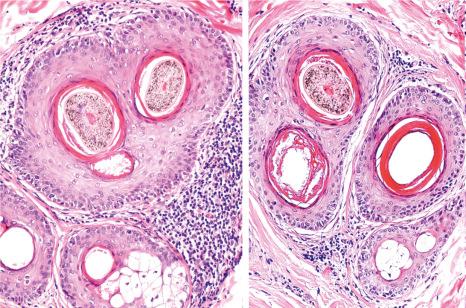
The miniaturization of hair follicles affects the whole of the hair follicle including, in late stages, the arrector pili muscle and the sebaceous gland. The degeneration and replacement of the arrector pili muscle by fat tissue and the loss of contact with the bulge occurring in the miniaturized follicle seems to be a critical factor in defining whether an androgenetic alopecia will respond to treatment. The persistence of the union between these two structures is a sign of the reversibility in alopecia as it appears to protect the integrity of the stem cells in the bulge even in the advanced stages of the process. The sebaceous glands remain normal, but in androgenetic alopecias of long evolution hyperplasia of the eccrine glands may be observed and sometimes form syringoma-like structures ( Fig. 22.47 ) .
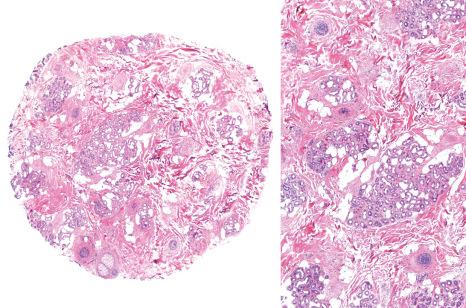
In deeper sections, hair bulbs are present at different depths, and they may be completely absent focally, with only follicular stellae remaining. These stellae are seen in a variety of conditions and reflect either miniaturized follicles or else follicles that have entered catagen or telogen stage ( Fig. 22.48 ) . As the stellae mature, they become less vascularized, presenting as fibrous scars with a blue-gray hue, which corresponds to condensations of elastic tissue known as Arao-Perkins bodies ( Fig. 22.49 ) . In late androgenic alopecia, the stellae become abnormally thick and could impede the growth of the follicle.
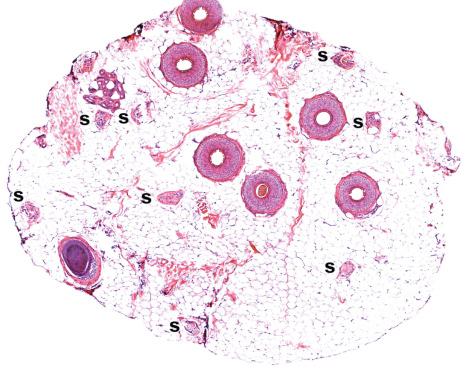
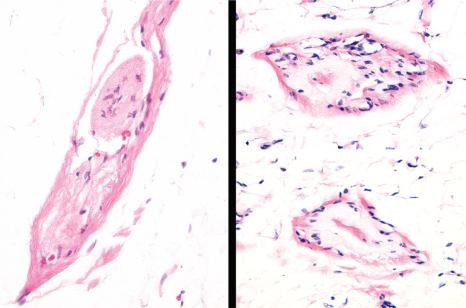
The terminal/vellus hair ratio (7 : 1) is much reduced and varies from 1 : 1 or even 1 : 2. Although initially the number of hair follicles is normal, in longstanding disease there can be a real reduction. A biopsy may therefore show a decrease in hair follicle density in addition to diminution in size of the individual hair follicles. Sometimes the appearances may be more suggestive of a scarring alopecia ( Fig. 22.50 ).
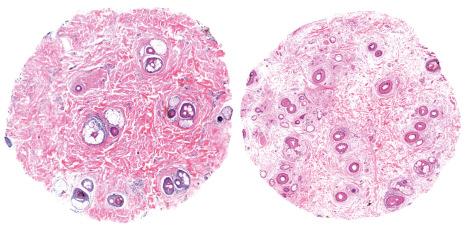
The most important differential diagnosis is with diseases which present with diffuse nonscarring alopecia including chronic telogen effluvium, alopecia areata, and fibrosing alopecia in a pattern distribution. In such cases, a biopsy is crucial to reach an accurate diagnosis.
Although androgenetic alopecia may show increased numbers of telogen hairs, telogen effluvium is clinically more diffuse and there are no miniaturized hair follicles. The biopsy from the occipital region is of great value in order to record whether or not the follicular involvement is diffuse. It is important, however, to note that both diseases may present simultaneously and that chronic telogen effluvium may uncover occult androgenetic alopecia.
Alopecia areata may show miniaturized hair follicles, particularly in its diffuse form and in very chronic cases. Characteristically, however, there is a prominent increase in the number of hair follicles in catagen and telogen, and usually a sparse peribulbar lymphocytic infiltrate is present, sometimes accompanied by eosinophils. Without adequate clinical information, however, distinction may be impossible.
In fibrosing alopecia in pattern distribution ( Fig. 22.51 ) the lymphocytic inflammatory cell infiltrate affects the infundibulum and the follicular isthmus and there is epithelial and bulge cell destruction. Additionally, there are apoptotic bodies, perifollicular fibrosis, and early loss of sebaceous glands.
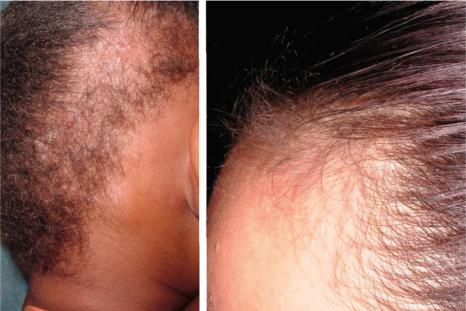
Temporal triangular alopecia (congenital triangular alopecia, Brauer nevus) was described by Saboreau in 1905. Although it usually appears in the early years of life rather than at birth, congenital cases are not rare. Familial cases rarely occur. Occasionally, the disease presents in adults. In the general population, the estimated incidence is 0.11%.
It involves one side of the scalp and characteristically presents as a single patch of alopecia with its base directed toward the frontotemporal area. Occasionally, other areas are affected and, exceptionally, patients show bilateral involvement. Clinical examination reveals vellus hairs in the almost complete absence of terminal hairs and inflammatory changes ( Fig. 22.52 ).
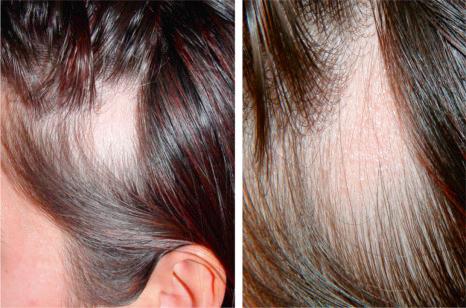
Temporal triangular alopecia has been described in association with aplasia cutis, phakomatosis pigmentovascularis, Down syndrome, Klippel-Trénaunay syndrome, mental retardation and epilepsy, in a mother and daughter, leopard syndrome, and congenital heart disease with renal and genital abnormalities.
The genetic basis of the disease is uncertain, but a paradominant trait has been suggested.
The diagnosis of temporal triangular alopecia is generally based on clinical features. A biopsy is only taken when the diagnosis is in doubt. Horizontal sections may be performed, paying particular attention to the most superficial sections at the level of the infundibulum.
The epidermis and dermis are normal, but there are almost no terminal hairs and the number of vellus hairs is increased. The sebaceous and eccrine glands are normal. Fibrous stellae and inflammation are absent ( Fig. 22.53 ). In general, the histologic appearance is very similar to that of a normal skin biopsy.
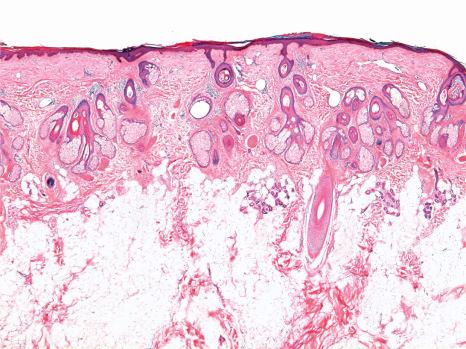
The differential diagnosis includes other causes of circumscribed nonscarring alopecia, particularly alopecia areata, tinea capitis, and trichotillomania. In the former, the bulbs of anagen follicles are surrounded and infiltrated by lymphocytes and there are terminal and miniaturized hair follicles cycling to catagen and telogen. In tinea capitis, the demonstration of fungal organisms by hydroxide potassium (KOH) or PAS and/or culture of the hair shaft are sufficient to establish a diagnosis. Clinical examination in trichotillomania reveals broken hairs. Histologically, besides pigmentary casts, terminal hair follicles – many of them in catagen and telogen – may be seen.
Alopecia areata is quite common, affecting up to 1% of the population. The frequency of a family history is very high, ranging from 10% up to 42% of cases. It is more common in individuals between 15 and 40 years of age, and about 60% of cases occur before the age of 20. The disease is very rare in newborns and young children. Exceptionally, however, congenital cases may occur.
The degree of involvement is very variable and can range from very mild disease where the hair loss is difficult to detect through to very severe cases with diffuse hair loss affecting the entire scalp or even the whole body ( Fig. 22.54 ). Any hair-bearing surface may be affected. A typical patient presents with an abrupt development of patches of nonscarring alopecia in different patterns: circumscribed, bandlike in the temporo-occipital region (ophiasic), bandlike in the frontoparietal region in a ‘sisaipho’ pattern (ophiasis inversus) ( Fig. 22.55 ), and reticular. When the patches extend and become confluent, involving the entire scalp, the appearance is known as alopecia totalis ( Fig. 22.56 ). If there is hair loss on the entire body, the condition is referred to as alopecia universalis. , Even in the most severe forms of alopecia totalis and universalis, one can observe isolated small groups of unaffected hair follicles. Alopecia areata may occasionally present with a pattern mimicking acute telogen effluvium, a positive pull test, and trichodynia (alopecia areata incognita). The proportion of patients who eventually develop alopecia totalis and universalis varies but is around 7%. Alopecia totalis is more frequent in children.
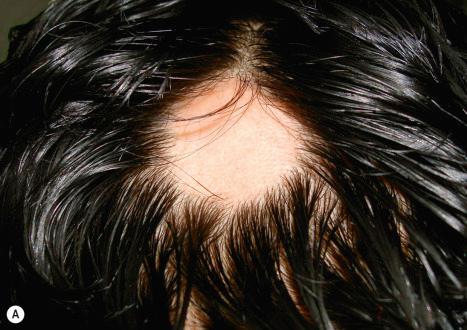
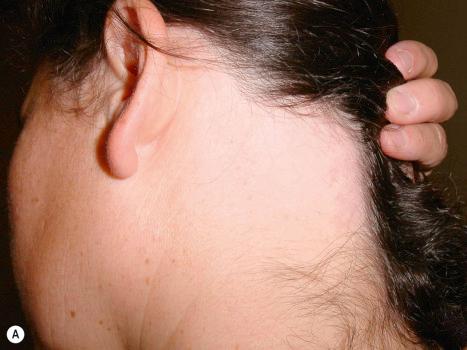
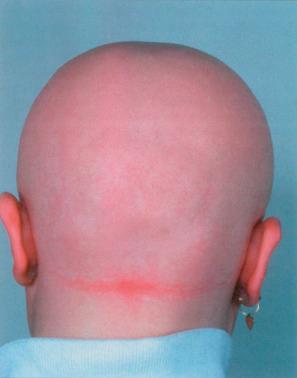
Examination of the involved scalp generally reveals that except for the absence of hair, the skin appears normal, follicular openings are preserved, and there is no evidence of scarring ( Fig. 22.57 ). In occasional cases, however, edema and erythema are observed.
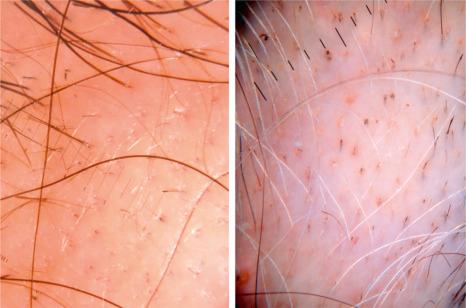
Hair color may appear normal or it may show mild lightening and loss of sheen. In the periphery of the patches of alopecia, one typically finds exclamation mark hairs, which are short and become thinner as they gradually approach the scalp. They are a very characteristic feature but may also be seen in trichotillomania. Sometimes, the damage to the hair follicles in anagen is so intense that the hairs break as soon as they emerge from the scalp. A dermoscopy finding consist of yellow dots, found in 95% of cases of the disease. The process usually affects pigmented hairs. Nonpigmented hairs appear to be more resistant, at least temporarily. This phenomenon of selective black hair loss where the gray hair is spared may give the impression of speedy graying (Marie Antoinette syndrome). When the hair grows back, it is often white or light brown and slowly recovers its normal color. Exceptionally, persistent white hair is a feature.
Alopecia areata sparing a congenital nevus of the eyebrow and a nevus flammeus has been called Renbök phenomenon (inverse Koebner phenomenon) and interpreted as a localized form of genetic resistance.
Nail changes may be present in patients with alopecia areata and include pitting, spotted lunula, and red lunula. Changes may be seen in one, several, or all of the nails ( Fig. 22.58 ). Trachyonychia (twenty-nail dystrophy) occurs in up to 3% of patients. The dystrophy may precede, coincide with, or occur after resolution of the episode of alopecia.
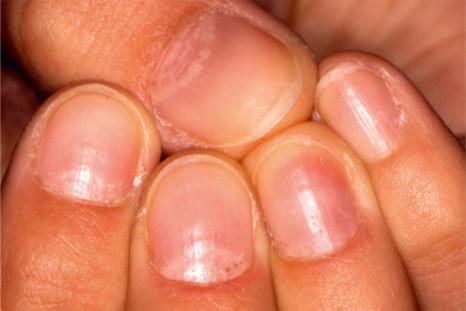
Alopecia areata has been associated with many other diseases. Some of these have an autoimmune etiology such as Hashimoto thyroiditis, type I (insulin-dependent) diabetes, Addison disease, vitiligo, hereditary thrombocytopenia (pseudo-von Willebrand disease), myasthenia gravis, polymorphism in the interleukin (IL)-1 receptor antagonist gene, lupus erythematosus, autoimmune polyendocrinopathy-candidiasis-ectodermal dysplasia syndrome (autoimmune polyglandular syndrome-1), common variable immunodeficiency, relapsing polychondritis, kidney-pancreas transplant recipients taking ciclosporine and after allogeneic bone marrow transplantation. Other associations include lichen planus, atopy, human immunodeficiency virus (HIV) infection, twenty-nail dystrophy, Down syndrome, cytomegalovirus and Epstein-Barr virus infection, celiac disease in children, chemotherapy, interferon-alpha (IFN-α), ribavirin, ciclosporine A, rifampicin, borderline tuberculoid leprosy, and ocular alterations (keratoconus, symptomless punctate lens opacities). It has also been observed in Clozapine-induced hypereosinophilia, narcolepsy type 1, and as recurrent disease after vaccination. Several biological agents such as etanercept, infliximab, and adalimumab are associated with the appearance or worsening of the illness. It has also developed in a patient with pili annulati. Patients with severe alopecia areata appear to have an increased incidence of nuchal nevus flammeus.
Prognosis in alopecia areata is variable and not very predictable in the individual patient. Nevertheless, it has been observed that the prognosis tends to be good in patients who have experienced hair growth with long-lasting remissions between episodes. Spontaneous remission can be expected in 34–50% of patients within 1 year, although almost all will experience more than one episode of the disease. Contrariwise, those who have had persistent hair loss or brief or incomplete remissions have a poor prognosis. The severity of alopecia areata at the time of first consultation and response to therapy is an important prognostic factor. The outlook is particularly poor in those patients with onset of the disease before puberty, those with a family history of the disease (present in 25% of cases), and those with alopecia totalis and alopecia universalis. Atopic patients appear to suffer a more severe form of alopecia areata.
Experimental studies have shown that alopecia areata is basically an organ-specific autoimmune disease thought to result from a collapse of hair follicle immune privilege, driven by cellular immunity with autoantibody production representing a secondary phenomenon. Autoantibodies to a diverse range of antigens including smooth muscle cells, gastric parietal cells, thyroid cells, and components of anagen hair follicles have been described.
It is unknown whether induction of the disease results from exposure to exogenous or endogenous antigens and whether it represents a consequence of an immune reaction to normal or aberrant epitopes. However, research suggests that the pathogenesis involves at least four events:
failure of the anagen hair follicle to maintain its privileged immunity (the inner root sheath and hair matrix do not express, or express very low level of, major histocompatibility complex class Ia antigens and maintains an active NK cell suppression) resulting in exposure of epitopes, which initiate an immune response,
antigen presentation, activation, and response of the lymphocyte to antigen-presenting cells,
migration of activated inflammatory cells and infiltration of hair follicles,
damage to the hair follicle by the inflammatory cell infiltrate.
It has been proposed that neurotrophins play a role in the pathogenesis of the disease. Since neurotrophins and their receptors are differentially expressed in subsets of immune cells in alopecia areata, a role for these proteins in the pathogenesis appears likely.
The increased frequency of alopecia areata in genetically related individuals suggests that there is a genetic link to the disease. Among the general population the condition does not display a mendelian pattern of expression since the resulting phenotype demonstrates variable degrees of hair loss. It has been proposed that expression of alopecia areata involves a complex interaction of multiple genes, in which major genes control susceptibility to the disease while other minor ones modify the phenotype.
Many illnesses with an autoimmune basis have been associated with specific human leukocytic antigens (HLA). Alopecia areata has been studied in association with both HLA class I and class II. The most relevant associations have been found with the HLA class II antigens (HLA-DR, -DQ, -DP). The molecular basis of this genetic association is supported by the fact that HLA binds and presents peptides derived from self and foreign protein antigens to the immune system for recognition and activation. More than 80% of all cases evaluated in one study were positive for the antigen DQB1*03 (DQ3), suggesting that this antigen is a marker for susceptibility. Furthermore, in patients with alopecia totalis and universalis, the frequency of the antigens DRB1*0401 and DBQ1*0301 (DR4 and DQ7) is significantly increased. HLA-DR5 has been linked to the early-onset and severe form of alopecia areata. Other HLA genes associated are NOTCH4 and MICA. Non-HLA genes associated with the disease are PTPN22 and AIRE.
In the last genome study supported by the genetic database of the national registry of alopecia areata in the United States, 139 nucleotides with polymorphism and significantly associated with alopecia areata were identified. There were eight different associated regions. One of such regions corresponds to the already well-known HLA complex. Seven loci genomes were also found. Five of them are expressed in the immunological system and two of them in the hair follicle. Interestingly, these genes were more related to illnesses such as diabetes type I, multiple sclerosis, rheumatoid arthritis, and celiac disease, rather than to psoriasis and vitiligo diseases to which they were initially thought to be associated. These diseases present a unifying mechanism known as ULBP3, which is the enhancement of the regulation of the danger signal in the target organ. Under normal circumstances, ULBP3 is not found in hair follicles, but in the affected hair follicles of alopecia areata it is prominent. These proteins attract the killer cells marked by the receptor NKG2D.
The effect of stress on the pathogenesis is unclear and controversial, although it has been suggested that it can trigger the disease. It has been observed that substance P and nerve growth factor could be acting as key mediators of stress-induced hair growth-inhibitory effects, through keratinocyte apoptosis, inhibition of hair follicle proliferation, and catagen induction.
Laboratory tests are not usually necessary for the diagnosis, but they may be of value in detecting associated conditions, particularly autoimmune disease. The hair-pull and hair-pluck tests show an increase in the number of telogen and dystrophic anagen hairs. The remaining anagen hairs are dystrophic because the continuous inflammatory process results in premature transformation into catagen and telogen phase. This abbreviated growth cycle results in many terminal follicles with poorly keratinized short stems that break readily (exclamation mark hairs).
Histologically, alopecia areata is characterized by four basic features:
normal numbers of follicular units and hair follicles in the initial stages with loss of follicles in the recalcitrant and most chronic phases,
an increase in the number of catagen and telogen hair follicles,
a lymphocytic infiltrate of variable severity affecting the bulbs of the anagen hair follicles and the catagen and telogen follicular stellae,
a tendency for hair follicles to become miniaturized in the more chronic and recalcitrants forms of the disease.
It is important to remember that the histopathological features depend on the stage of the disease.
The best site to take biopsies from is the periphery of an active lesion. The extraction (hair-pull tests) and dermoscopy are useful when it comes to selecting the most active areas as one can observe exclamation point hairs, yellow dots, or black dots.
All the changes in alopecia areata described in vertical sections are better observed in horizontal sections ( Fig. 22.59 ). This is particularly true of hair bulb lymphocytic infiltration. Nevertheless, the inflammatory infiltrate is not always visible. The frequency with which this and other histologic changes are observed depends on the stage of the illness when the biopsy is performed.
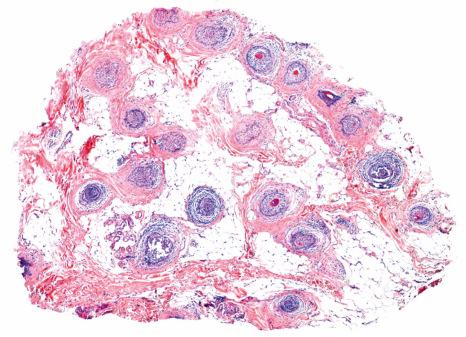
In the early stages of the disease, the peribulbar inflammatory infiltrate is intense ( Fig. 22.60 ). However, the infiltrate gradually decreases and there is an increase in the number of catagen and telogen hair follicles. Telogen counts may exceed those seen in telogen effluvium ( Fig. 22.61 ). The follicles show a variable inflammatory lymphocytic infiltrate in the peribulbar region ( Figs 22.60 and 22.62 ). This may occasionally be very mild, even in more active lesions. The latter feature is particularly noticeable in the atypical, incognita, and ophiasic forms of the disease ( Fig. 22.63 ). The presence of eosinophils in the stellae and within the hair bulbs has been described as an early and typical feature. The earliest follicular changes consist of loss of structural integrity of the centrally located supramatrical upper bulbar region and shrinkage of hair bulbs. The hair matrix is infiltrated by lymphocytes, and there is also pigment incontinence, matrix cell necrosis, and vacuolar damage. The inflammatory infiltrate is especially prominent in terminal hair follicles, the bulbs of which are located in the subcutaneous tissue ( Fig. 22.64 ). Pigment incontinence may be very conspicuous and lead to the formation of clumps of melanin pigment (pigment casts) in the distorted hair bulb and follicular streamer ( Fig. 22.65 ). The infiltrate is composed of an admixture of CD4+ and CD8+ T lymphocytes ( Fig. 22.66 ).
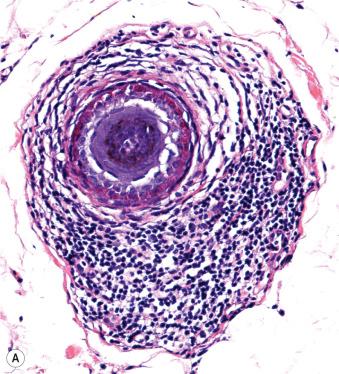
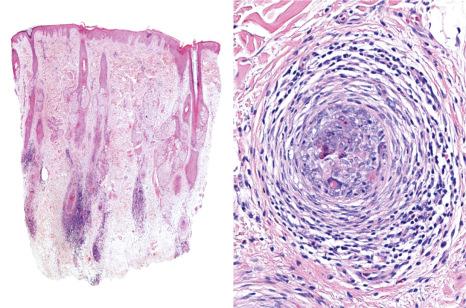
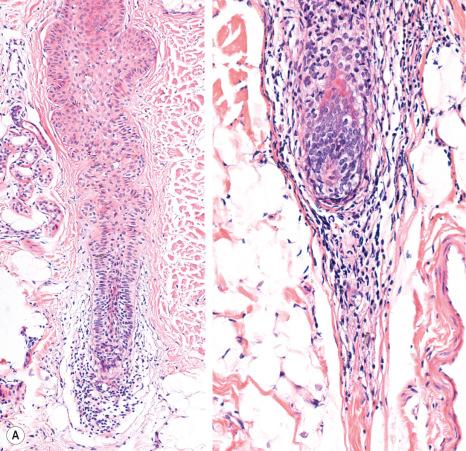
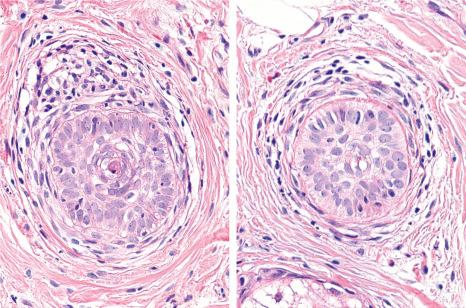
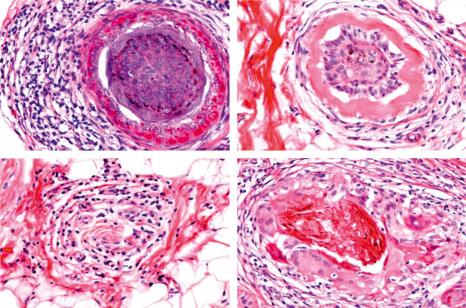
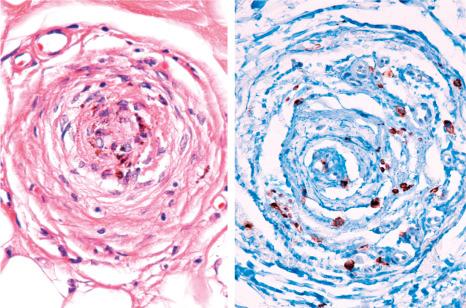
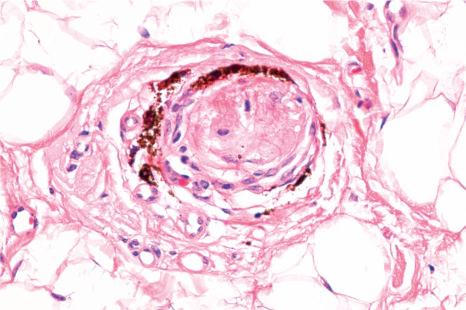
In the upper part of the hair follicle within the epidermis, one can observe dilated infundibulae filled with keratin which correspond to the yellow dots seen clinically ( Fig. 22.67 and see Fig. 22.57 ). Those in horizontal sections could display a swiss cheese pattern.
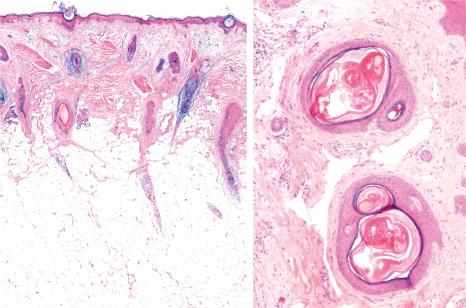
Immunofluorescence studies have shown deposits of C3, IgG, and IgM along the basement membrane of the inferior part of the hair follicle. Once the follicle enters catagen stage and progresses to telogen, the inflammatory cell infiltrate decreases.
Follicular lymphocytic infiltration is accompanied by progression to catagen and telogen. After this, the hair follicle rapidly returns to anagen and the cycle starts again. Because of this continuous cycle and the accompanying inflammatory process, the follicles go through two important morphological changes:
trichomalacia characterized by short, incompletely keratined (pencil-point) hairs which are susceptible to trauma,
miniaturization of some anagen follicles.
In the late stage of the disease, the inflammation decreases and numerous miniaturized hair follicles and telogen follicles are present. The number of miniaturized follicles increases with chronicity, and these may simulate hair follicles in late anagen stage. Such hairs are found in the middle or upper dermis and have been described as nanogen. They represent an intermediate stage between vellus and terminal anagen hair follicles. In horizontal sections there is generally no hair shaft production, although occasionally a very thin incompletely keratinized form is produced, correlating with the empty infundibula observed on the scalp. In vertical sections the proximal end of the hair shaft acquires a ragged appearance instead of the normal club shape. These hair follicles can sometimes display histologic features of the anagen, catagen, and telogen phases simultaneously with evidence of growth and involution in the form of mitotic activity and apoptosis ( Fig. 22.68 ).
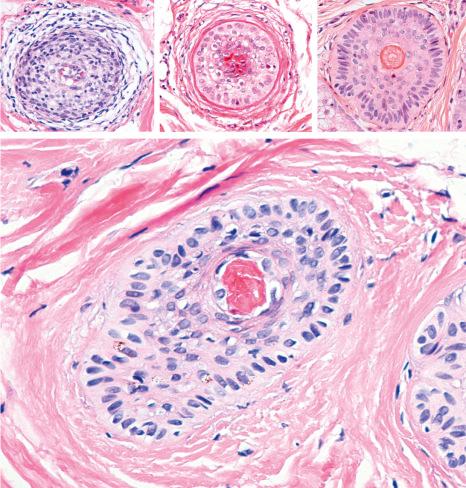
In longstanding alopecia areata, the majority of the hair follicles are in catagen and telogen. Since the inflammatory infiltrate does not affect hair follicles in these growth phases, inflammation may be absent in the subcutaneous tissue ( Fig. 22.69 ).
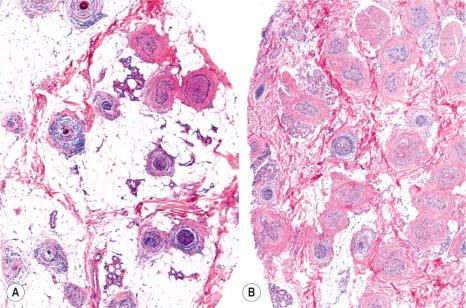
Inactive alopecia areata can resemble androgenetic alopecia with many miniaturized hair follicles ( Fig. 22.70 ).
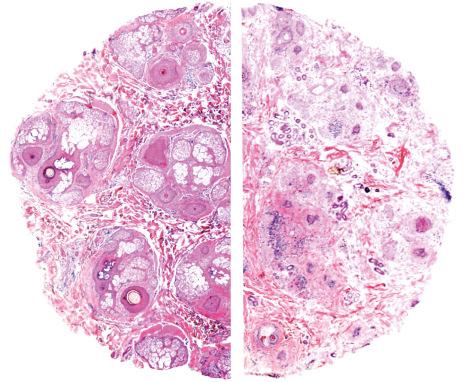
Numerous stellae are present in the deep dermis and the subcutaneous tissue, and these may be accompanied by an inflammatory cell infiltrate and melanin pigment ( Fig. 22.71 ). In some cases, there may be destruction of the hair follicle by the inflammatory cell infiltrate and this is associated with histiocytes and giant cells (see Fig. 22.64 ).
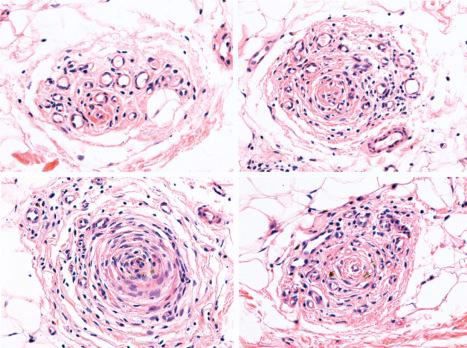
In patients presenting with trachyonychia, a nail biopsy usually shows a lymphocytic infiltrate with exocytosis and spongiosis involving the proximal nail fold, nail matrix, nail bed, and hyponychium. Rarely, the histology is indistinguishable from lichen planus.
The differential diagnosis of alopecia areata varies depending on whether the clinical pattern of hair loss is localized or diffuse.
In cases with localized areas of hair loss, the differential diagnosis includes trichotillomania, triangular temporal alopecia, syphilis, discoid lupus erythematosus, lichen planopilaris, frontal fibrosing alopecia, pseudopélade, tinea capitis, and psoriatic alopecia.
Trichotillomania may closely simulate alopecia areata but microscopic examination in the former condition shows more pigmented casts, an absence of miniaturized hairs, and minimal inflammatory infiltrate. Triangular temporal alopecia shows no clinical or histologic evidence of inflammation and there is no excess of hair follicles in telogen or catagen. Alopecia syphilitica may be very similar but clinically the plaques rarely show complete absence of hairs. Histologic examination can also be problematical since both conditions show a peribulbar inflammatory cell infiltrate. Eosinophils are not frequent in syphilis but plasma cells tend to be prominent. Serology is often essential in difficult cases.
Discoid lupus erythematosus, lichen planopilaris, and frontal fibrosing alopecia display more prominent inflammation in the upper segment of the follicle, around the bulge, and result in scarring alopecia with interface change and permanent loss of terminal hair follicles. Direct immunofluorescence is useful to confirm the diagnosis in the first two conditions. Equally, the presence of dermal mucin is a diagnostic clue in discoid and systemic lupus. It is important however, to keep in mind that both entities may coexist. The incidence of alopecia areata in patients with lupus erythematosus may even reach 10%. Cases of lupus panniculitis clinically simulating alopecia areata have also been described. In pseudopélade, there is extensive scarring, with loss of terminal hair follicles and a mild inflammatory cell infiltrate localized to the upper segment of the follicle. Tinea capitis also shows an inflammatory infiltrate in the upper segment of the hair follicle with neutrophils, lymphocytes, and histiocytes. The fungi are usually easily found in association to the hair shaft with a PAS stain and may be grown in Sabouraud agar. Psoriatic alopecia may be distinguished by the presence of typical changes of psoriasis in the interfollicular epidermis and the atrophy of the sebaceous glands. It is important to highlight that there is a type of psoriatic alopecia/alopecia areata-like reaction secondary to antitumor necrosis factor-α therapy with simultaneous histologic changes of alopecia areata and psoriatic alopecia associated with an inflammatory cell infiltrate of plasma cells and eosinophils.
The differential diagnosis of diffuse alopecia areata is mainly telogen effluvium and androgenetic alopecia. Clinically, telogen effluvium and androgenetic alopecia never produce such extensive hair loss as that seen in the most severe variants of alopecia areata including alopecia totalis and alopecia universalis. In the less severe cases, histologically, telogen effluvium lacks inflammation and there is only an increase in the number of telogen hair follicles. In androgenetic alopecia, the histologic presentation may be very similar to that of chronic areata alopecia as in the former the miniaturization of hairs may be very extensive. However, the lack of lymphocytic infiltration and the different clinical picture are aids in the differential diagnosis.
Alopecia areata incognita may be particularly difficult to differentiate from chronic telogen effluvium as both share a large number of hair follicles in telogen. However, dermoscopy in the former shows the presence of a larger number of yellow dots; furthermore, there may be a greater tendency to miniaturization. Recently, with the use of immunohistochemistry there has also been an emphasis in the detection of high levels of UL16 binding protein-3 (ULBP3) as an aid in the diagnosis of alopecia areata incognita
Psoriatic alopecia was first described in 1972 by Shuster. Between 50% and 80% of patients with psoriasis will develop scalp involvement at different stages during the course of the disease. Psoriatic alopecia may be caused by psoriasis itself, by systemic or topical therapy, or may be associated with other autoimmune diseases particularly alopecia areata. The most common form of presentation is involvement of skin already affected by psoriasis ( Fig. 22.72 ). Another way in which psoriasis may cause hair loss is through effluvium telogen particularly in the course of erythrodermic or generalized pustular psoriasis.
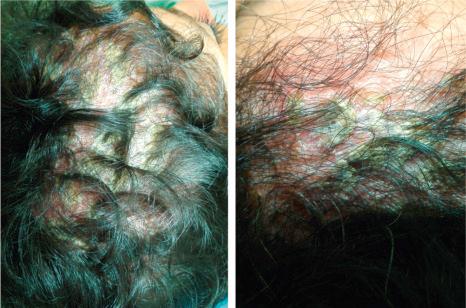
The majority of the patients with psoriatic alopecia present with a reversible nonscarring alopecia. Only a small percentage of patients will develop scarring alopecia secondary to psoriasis. This seems to be related to the duration and intensity of the inflammatory process. However, it is not always clear which patients will develop a reversible nonscarring alopecia or scarring alopecia.
An association has been found between psoriatic alopecia, alopecia areata, and Renböck phenomenon. Drugs that have been associated with psoriatic alopecia include methotrexate, hydroxyurea, retinoids, lithium, and carbamezapine The use of tumor necrosis factor-alpha inhibitors, particularly infliximab and adalimumab, in patients with Crohn disease has also been linked with the disease.
The mechanism leading to atrophy and loss of sebaceous glands in psoriasis is unknown. An explanation could be that some of the numerous cytokines secreted in psoriasis are responsible for the damage to the sebaceous glands or that they are lost because of the inflammation around the superior segment of the hair follicle.
Histologic changes in both scarring alopecia and nonscarring psoriatic alopecia include typical features of psoriasis in the interfollicular epithelium, namely, psoriasiform hyperplasia of the epidermis, hyper- and parakeratosis with hypogranulosis, and exocytosis of neutrophils to the areas of parakeratosis. The infundibulum becomes dilated and there is a noticeable increase in the number of catagen and telogen hair follicles, pronounced atrophy and eventual loss of sebaceous glands, and a perifollicular lymphocyte inflammatory cell infiltrate in the superior and inferior segments of the hair follicle, including the hair bulb. There may be some miniaturization. The inflammation may lead to a granulomatous foreign body reaction with follicular destruction. At a later stage perifollicular fibrosis and fibrous tracts with inflammation may be observed ( Fig. 22.73 ). Sometimes the changes in the superficial epidermis closely simulate those seen in seborrheic dermatitis ( Fig. 22.74 ). Psoriatic alopecia associated with tumor necrosis factor-alpha inhibitors is histologically very similar to conventional psoriatic alopecia but more severe with a more prominent inflammatory cell infiltrate including plasma cells and eosinophils.
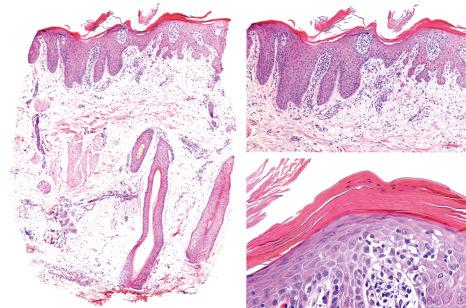
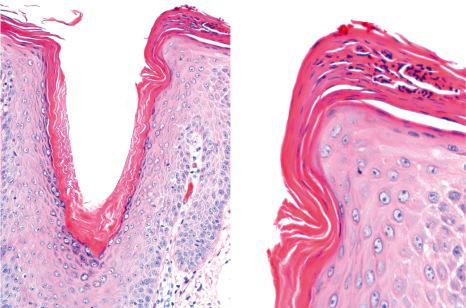
The most important histologic differential diagnosis is with alopecia areata. In alopecia areata, there are no epidermal changes of psoriasis and there is no loss of sebaceous glands.
Traumatic alopecias are caused by physical agents that act on the scalp, inducing hair loss of variable degree that range from transitory to permanent alopecia. This section will review those traumatic alopecias in which a biopsy may be useful to establish a diagnosis. These include trichotillomania, pressure alopecia, and traction alopecia.
Trichotillomania was described in 1889 by Hallopeau. It is a variant of traumatic alopecia caused by traction and pulling of hair. It mainly affects young women but can also be found in older adults and children, including toddlers. Although some patients admit to pulling their hair, in our experience the great majority emphatically deny this. For this reason, a thorough interview and detailed psychiatric history are usually required.
Trichotillomania constitutes a chronic mental illness, of variable intensity and presentation, which can lead to severe emotional and social limitations to the patient's life. Trichotillomania shares some characteristics with obsessive-compulsive disorder. In the most severe cases, it can be associated with deeper personality disorders such as self-harming, trichophagia, and trichobezoar (Rapunzel syndrome). Occasionally, the compulsion to pull hair is not limited to the scalp but can involve other body sites including the pubis, the eyebrows, the eyelashes, and even the nostrils.
Trichotillomania may be as common as obsessive-compulsive disorder and affect as many as 3% of the US population. Subclinical forms are also quite common, possibly affecting 1 in 10 Americans.
There are two patterns of chronic hair pulling. The most severe and disfiguring is that in which patients pull off large amounts of hair during a brief period, and this is triggered by negative affective states. The least severe pattern is that of patients who engage in hair pulling during sedentary and social activities, such as reading, watching television, or talking on the telephone.
The pattern of hair loss in trichotillomania is very variable, ranging from involvement of an isolated area (the ‘friar Tuck sign’) through to multiple geometric zones that may affect practically the entire scalp ( Figs 22.75 and 22.76 ). In contrast to alopecia areata, the hair loss is typically incomplete. In every individual affected area there is hair loss, but this is not total, as the use of a magnifying glass shows residual small, broken, nonpigmented hairs. Sometimes there is evidence of erythema, pustule formation, or traumatic excoriations ( Fig. 22.77 ). It is not infrequent to find other hair-bearing areas affected ( Fig. 22.78 ).
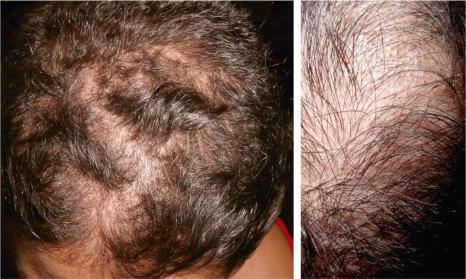
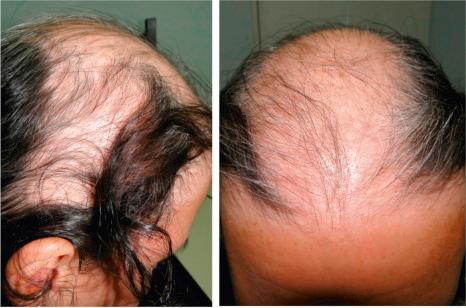
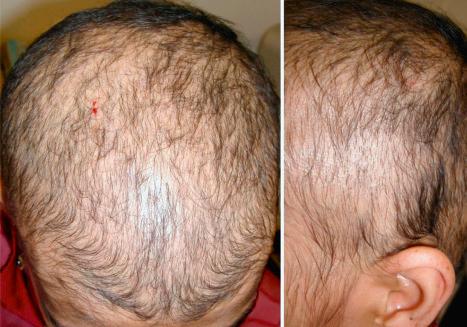
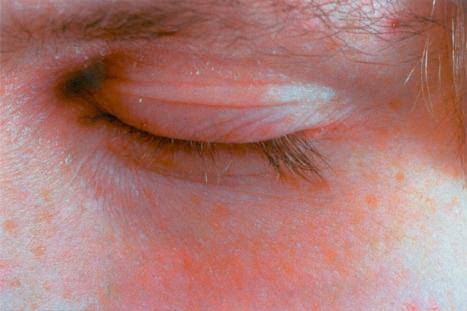
Owing to the shortness of the hairs in this form of alopecia, it is usually not possible to obtain hairs by the hair-pull or hair-pluck techniques. Hairs evaluated by these techniques at the edges of the areas of alopecia are normal.
The hair-growth window technique is very useful in the diagnosis of trichotillomania. It involves shaving an area of 2.0 cm 2 on the scalp such that the patient cannot pull hairs from this site (back of the head). If possible, this area should be chosen so that adjacent hairs may hide the shaved area ( Fig. 22.79 ). A diagnosis of trichotillomania is confirmed if, by the end of a week, hairs are developing normally. Hair growth is evaluated after a period of 1 week only because at this stage normal hairs are still very short and the patient cannot reach them. The hair grows by about 1.0 cm per month, and in 1 week the length of the hair should average 2.5 mm. However, the individual hair growth rate may be heterogeneous on the scalp.
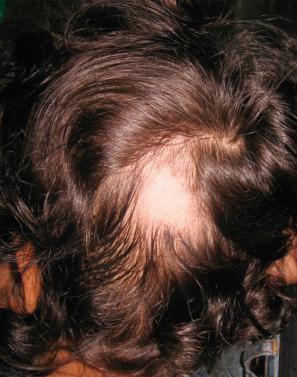
In rare patients with extensive trichotillomania, a moth-eaten appearance is seen such that it may be necessary to exclude syphilis by serology.
The histologic features of trichotillomania are quite distinct and, with clinical correlation, enable the diagnosis to be made in the majority of cases. In horizontal and vertical sections it is fairly easy to observe the most important histologic components, which only affect terminal follicles. The miniaturized vellus and follicles are protected from being pulled out because of their short length. The most important histologic alterations are catagen follicles, pigmented casts, and traumatized and distorted hair follicles.
The best biopsies are obtained in the first 2 months after the hairs have been pulled. Many sections should be examined because only a few sections may show the characteristic changes.
At scanning magnification, the most salient features consist of very high percentage of catagen or telogen hair follicles, a number of normal hair follicles, and absence of inflammation ( Fig. 22.80 ). The affected hair follicles are easily recognized because they contain dark-red keratin and the external root sheath displays extensive apoptosis (see Figs 22.26 and 22.29 ).
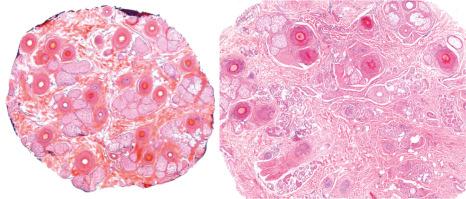
Pigment casts correspond to pigmented cells in the hair matrix and cortex, which due to traction are dislodged and become displaced to the hair canal, outer root sheath, fibrous streamers, and the dermal papilla.
In trichotillomania, pigment casts are seen at every level of the hair canal, mainly in the infundibulum and in the ostium, and are associated with hyperkeratosis ( Figs 22.81 and 22.82 ). These casts are occasionally observed in alopecia areata, chemotherapy-induced alopecia, and pressure induced alopecia. They may be difficult to detect in poorly pigmented blond or red-haired individuals. Another morphological alteration observed has been the presence of a vertically oriented split within the hair shafts. This split defect is full of proteinaceous material and erythrocytes. The histologic image is reminiscent of a hamburger within a bun (the ‘hamburger sign’) ( Fig. 22.83 ). Sometimes, the pigmented material takes other shapes similar to a zipper or a button and its buttonhole.
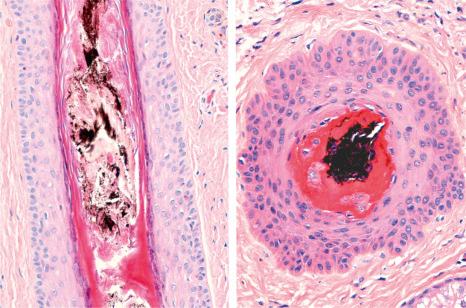
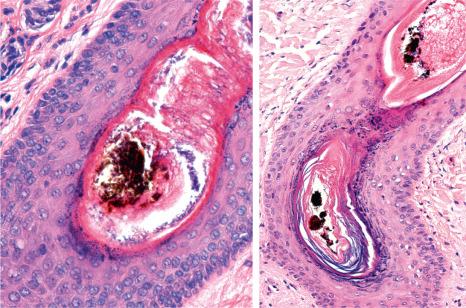
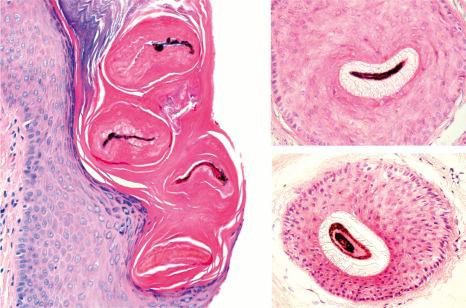
Traumatized and distorted hair follicles represent follicular structures that display different alterations. The most frequent changes consist of collapse of the inner root sheath, inter- and intrafollicular hemorrhage, and trichomalacia. The latter refers to distorted, small, and incompletely keratinized hair follicles with walls of uneven thickness ( Fig. 22.84 ). They may show irregular pigmentation. Despite the extensive anatomical and physiological alteration of the hair follicles in trichotillomania, inflammation is minimal. Additional histologic findings include pigmented follicular stellae ( Fig. 22.85 ).
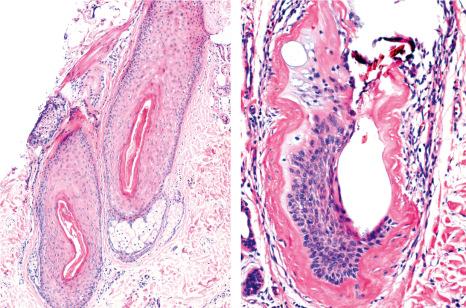
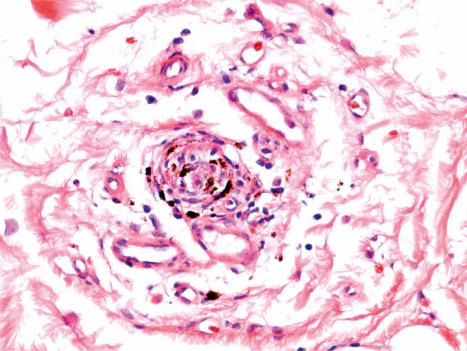
The most important clinical and histologic differential diagnosis of traumatic alopecia, particularly trichotillomania, is alopecia areata. In the latter, one can also occasionally find pigmented casts and trichomalacia. However, in alopecia areata the latter component is minimal and there are telogen follicles, small anagen follicles, miniaturized hairs, and a peribulbar inflammatory cell infiltrate. Syphilitic alopecia may also resemble trichotillomania clinically, but the pigmented casts, trichomalacia, and absence of an inflammatory cell infiltrate in the latter condition usually afford their easy distinction. In difficult cases, however, serology is sometimes necessary.
Two other conditions that must be kept in mind in the differential diagnosis are trichotemnomania, an obsessive-compulsive habit to cut the hair with scissors or with a razor, and trichoteiromania, which results from perpetual rubbing of the scalp with fracturing of the hair shafts. Related to the latter is the appearance of frictional hair loss due to continuous pressure from items of clothing such as socks and trousers or the bed. The latter entities have no diagnostic histopathological features and show normal histology.
Abel and Lewis first described postoperative (supine or pressure) alopecia in 1960. Pressure alopecia is an uncommon complication of surgery and is reported mainly in adults who undergo anesthesia, typically affecting the occiput and resulting from head immobilization during prolonged periods of unconsciousness. The pressure induces tissue hypoxia and ischemia. Most alopecia is temporary, but rare cases are permanent. Pressure alopecia was first described after long-lasting gynecological operations. It has also been reported after cardiac, gynecological, abdominal, esthetic, and breast reconstruction surgery. Further associations include numerous surgical and therapeutic procedures, and occurrence in severely ill or comatose patients. It is more frequent after cardiovascular surgery, prolonged endotracheal intubation, prolonged head immobilization, and the intraoperative use of the Trendelenburg position.
Patients with this condition typically complain of occipitoparietal pain and tenderness within 24 hours of surgery. Hair loss is usually complete within 3–28 days after surgery. Most cases are self-limiting with regrowth occurring within 12 weeks. However, there are reported cases of permanent alopecia.
The histopathology in early stages shows vascular thrombosis and necrosis of the dermis and subcutaneous tissue. Later, the microscopic findings include features in common with trichotillomania, including the presence of pigment casts, abundant catagen and telogen follicles, melanophages, and apoptotic bodies.
Distinction from other causes of localized hair loss is usually easy and can be done on clinical grounds alone. However, the differential diagnosis with chronic radiodermatitis after intraoperative fluoroscopic imaging may be problematic. In these cases, the antecedent of having been exposed to radiation and the location of the bald patches along the scalp margins with an ophiasis pattern is an important clue. The latter pattern occurs because this is the area of the scalp that receives the highest dose of radiation during fluoroscopy.
Traction alopecia is another form of traumatic alopecia secondary to the application of tensile forces to the hair of the scalp with a histologic pattern similar to that of trichotillomania. It is a reversible form of alopecia which presents in adults and children. It may become a permanent alopecia and result in a scarring alopecia if the traction is intense and sustained. Its causes are varied and often related to cultural and cosmetic practices. The most important are secondary to grooming styles such as excessive brushing, hair weaves, tight braiding, ponytails/pigtails, buns (chignon alopecia), cornrows, or wearing elastic hair bands. Traction alopecia is particularly frequent in individuals of African descent (ancestry) ( Fig. 22.86 ). Other variants of traction alopecia may occur in nurses as a result of the use of a cap and among Sikh males from wearing a turban. It has also been reported from hair extensions and a recognized feature as a sequel of torture.
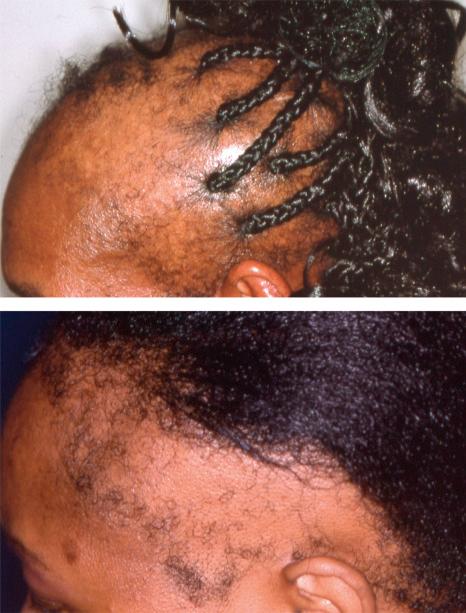
The hair loss usually occurs in the frontal and temporal areas but depends on the hairstyle used, and it is particularly noticeable at the margin of the tightly styled hair, leading over time to a widening of the parting lines, with retained hairs along the frontal and temporal rim called the ‘fringe’ sign ( Fig. 22.87 ).
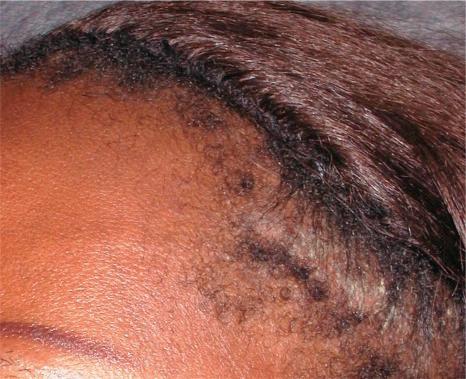
A recent observation with potential therapeutic implications is the finding that the piloerection induced by α1-AR agonists makes hair extraction difficult and this indirectly protects against the development of alopecia.
The biopsy should be processed in short horizontal sections as this may provide more information, particularly when the traction details are not very clear.
The microscopic features are biphasic and depend on the time at which the biopsy is taken. In the early phases, there is a normal number of terminal hair follicles, some inflammation, abundant hair follicles in telogen and catagen, and trichomalacia ( Fig. 22.88 ). As the process evolves, the terminal hair follicles disappear and only miniaturized follicles mixed with fibrous tracts are left. The number of sebaceous glands may be diminished.
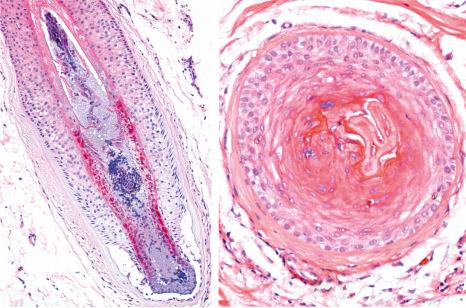
The differential diagnosis is mainly with those alopecias that show a bandlike pattern of hair loss, such as alopecia areata in an ofiasic pattern and frontal fibrosing alopecia especially when the clinical history is not very clear ( Fig. 22.51 ). Nevertheless, the clinical findings of preservation of ostium follicles and histologic findings of a peribulbar inflammatory cell infiltrate are enough to allow the diagnosis of alopecia areata to be made. In fibrosing frontal alopecia, there is clinical evidence of erythema and perifollicular scaling and histologic features of an interphase lymphocytic inflammatory cell infiltrate in the upper segment.
Late traction alopecia is often indistinguishable on histology grounds from end-stage cicatricial alopecia. In difficult cases, clinicopathological correlation is essential.
Senescent (senile, involutional) alopecia most probably represents a physiological event, as the majority of elderly people develop loss of hair pigment (canities), and there is a diffuse decrease in the density and thickness of the hair in the scalp, axillary, and pubic regions ( Fig. 22.89 ). Typically, patients with senile alopecia are older than 50, although the predictive value of age in total hair count has been found to be limited. Patients have no relevant family history of alopecia. In some animal models, such as female squirrel monkeys ( Saimiri boliviensis ), age-related alopecia has been observed.
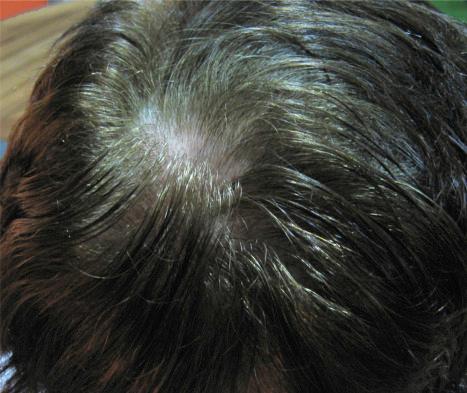
The hair-pull/hair-pluck tests are normal with no increase in the number of telogen hairs.
Senescent alopecia is a controversial concept. It has characteristics that defined it as an entity and probably related to accumulative oxidative stress directly related to age; yet, sometimes the separation from androgenic alopecia or telogen effluvium is not clear.
Horizontal sections are very useful in the diagnosis of senile alopecia, particularly if the biopsies are from two different sites, because they allow a comparative evaluation in relation to the diffuse or localized nature of the process allowing distinction from other types of alopecia.
Histologically, there is a slight decrease in the number of follicular units and terminal hair follicles, with a normal ratio between terminal and vellus hair follicles and between anagen and telogen hair follicles ( Fig. 22.90 ).
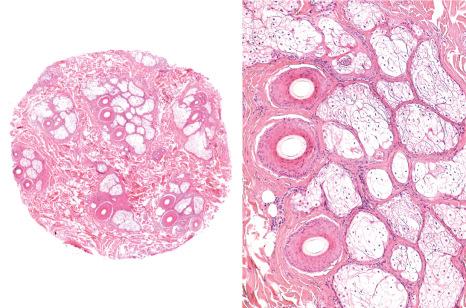
Distinction from telogen effluvium and from androgenetic alopecia may be difficult but the pattern of diffuse involvement, without an increase in the percentage of telogen hairs or an increase in the number of vellus hairs, is very suggestive of senile alopecia.
Telogen effluvium is one of the most frequent forms of diffuse hair loss in women. In general, the term is applicable to those cases in which there is an early end to anagen stage with progression of many hairs to catagen and subsequently to telogen.
Telogen effluvium was first described by Kligman in 1961 to refer to a phenomenon of increased loss of telogen hairs in different processes without making any reference to a particular disease. Telogen effluvium is characterized by diffuse hair shedding. There are two clinical presentations: an acute self-limiting presentation, lasting less than 6 months, generally precipitated by a recognizable event, and a chronic presentation of longer duration and unknown etiology.
Acute telogen effluvium may be precipitated by an extensive range of events and diseases, such as:
physiological processes such as telogen effluvium in the newborn and postpartum, severe psychological stress, crash diets,
pathological events including spinal cord injury, intense fever (malaria, yellow and typhoid fevers), severe systemic illnesses, major surgery, anesthesia, septicemia, HIV-1 infection, after orthognathic surgery, early androgenetic alopecia, hypothyroidism, hyperthyroidism, iron-deficiency anemia, eosinophilia-myalgia syndrome, Hodgkin lymphoma, contact dermatitis of the scalp, and eating disorders.
A number of drugs have also been implicated. The most relevant include antihyperlipidemic agents, retinoids, anticoagulants, antithyroid medications, anticonvulsants, heavy metals, propranolol, nadolol, metoprolol, minoxidil, oral contraceptives, heparin, clofibrate, salicylates, gentamicin, nicotinic acid, nitrofurantoin, vitamin A, albendazole, IFN-α2b, imiquimod, and the dopamine agonist pramipexole. The list of drugs associated with telogen effluvium is continuously increasing and may be consulted in specialized references. Drug-induced hair loss is often reversible and may present in various forms such as telogen effluvium, anagen effluvium, or both.
A seasonal increased hair loss (seasonal alopecia) has been observed in clinical practice.
Most patients are adults, mainly women, but the process also occurs fairly commonly in children and adolescents. Associated trichodynia has been documented.
On examination, patients show diffuse noninflammatory hair loss involving the entire scalp ( Figs 22.91 and 22.92 ). The loss of hair begins approximately 3–4 months after the precipitating event and, although it can be significantly noticeable, baldness is never observed ( Fig. 22.93 ). Telogen effluvium can overlap with androgenetic alopecia.
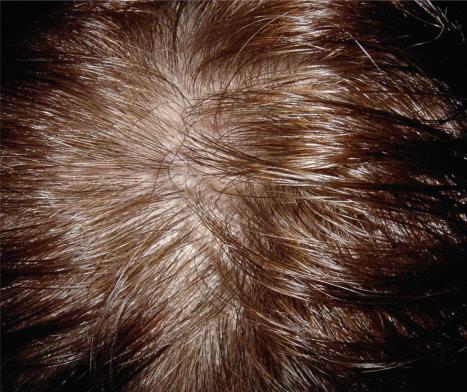
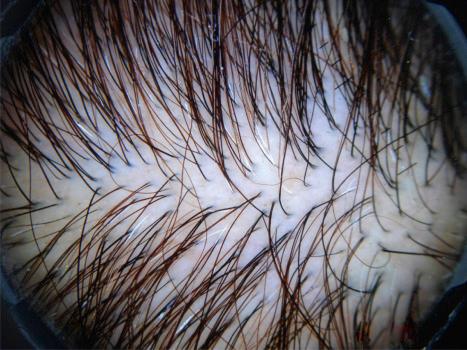
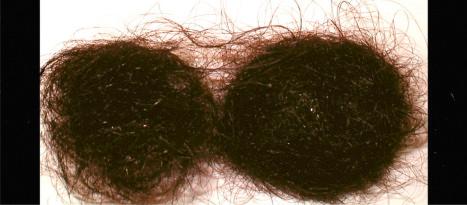
The hair-pull test and trichogram show a net increase in the number of telogen hairs (see Figs 22.3 and 22.4 ). The number of telogen hairs varies from individual to individual and also according to the stage of evolution of the disease. In the initial stages the telogen hair count in trichogram is high, but by the end of the process almost normal counts may be found. The upper normal limit of telogen hairs is considered to be 15% of terminal hairs. Between 15% and 20% is suggestive of effluvium telogen, yet this count is the most frequently found in chronic effluvium telogen. More than 20% is a determinant of the disease. The hair-pull test is positive in all areas of the scalp ( Fig. 22.94 ).

Owing to the great number of diseases that may present as telogen effluvium, a thorough clinical history is necessary. Diagnostic tests to identify the etiology and cause of the disease are also required. It is often prudent to carry out laboratory tests to exclude or confirm a subclinical illness such as hypothyroidism, systemic lupus erythematosus (SLE), or syphilis.
Some studies have found decreased ferritin and serum iron levels in females with telogen effluvium, androgenetic alopecia, and alopecia areata. The clinical and therapeutical significance of these findings is still unclear, as other studies have not found any relationship between iron deficiency and hair loss. Currently, in the absence of a clinical setting suggestive of anemia (menstruating women, vegetarians, and women with a history of anemia), there is insufficient evidence to recommend universal screening for iron deficiency in patients with hair loss.
Some patients, particularly middle-aged postmenopausal women, may present with a chronic form of telogen effluvium that lasts more than 6 months, is of unknown etiology, has a fluctuating course, and is characterized by a diffuse pattern of hair thinning and hair loss, often associated with bitemporal recession (chronic telogen effluvium). The biopsy generally shows borderline findings between a biopsy with no alterations and a telogen effluvium of low intensity. Baldness does not develop because lost hairs are quickly replaced. The disease appears to be self-limiting, but some patients continue to experience chronic diffuse telogen hair shedding without tendency toward spontaneous improvement or development of female pattern hair loss. An exceptional case has been documented in a man.
Telogen effluvium is caused by a disturbance of the hair cycle which results in telogen shedding. It has been proposed that telogen effluvium develops as a result of five different functional changes in the hair follicle:
immediate anagen release (episode of fever, stress or medication),
delayed anagen release (postpartum),
short anagen syndrome (chronic telogen effluvium),
immediate telogen release (topical minoxidil therapy, seasonal alopecia),
delayed telogen release (a theoretical possibility).
These different mechanisms are precipitated by the different stimuli and processes mentioned above. The underlying molecular mechanisms controlling these processes are unknown. Interestingly, however, it has been shown that inducible transgenic mice, which display a reversible hair loss phenotype, express high levels of the transcription factor tTA (tetracycline transactivator) and reporter luciferase gene. This results in a decreased number of anagen hair follicles and an increase in the number of telogen hair follicles.
Although the diagnosis can be made on clinical grounds, when the clinical presentation is unclear, a biopsy may be necessary. Ideally, two biopsies should be taken from different sites and processed with horizontal sections to verify the diffuse nature of the process and to produce an exact count of the number of hair follicles in telogen, catagen, and anagen and the number of miniaturized hair follicles. The histologic findings in telogen effluvium are subtle, the only finding being an increase in the number of telogen germinal units ( Fig. 22.95 , and see Figs 22.29–22.31 ), telogen hair follicles ( Fig. 22.96 ), and follicular stellae ( Fig. 22.97 ) in the deep layers, with a normal number of hair follicles and absence of a significant inflammatory infiltrate or follicular miniaturization. The follicular stellae are identical to those observed in androgenic alopecia. These changes are better observed when the illness is active, as in the resolution state the number of follicles in telogen may be normal. It is very important to bear in mind this fact, as normally this is the moment in which the patient notices the shedding and consults the dermatologist. Many scalp biopsies that appear ‘normal’ or ‘supernormal’ (all terminal follicles in anagen) belong to patients with the clinical diagnosis of telogen effluvium. The percentage of telogen terminal hair follicles is generally greater than 20%; however, this figure should not be taken as a rigid definition since lower counts are occasionally found in patients with chronic disease as discussed before.
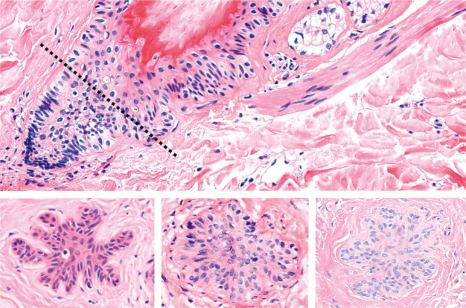
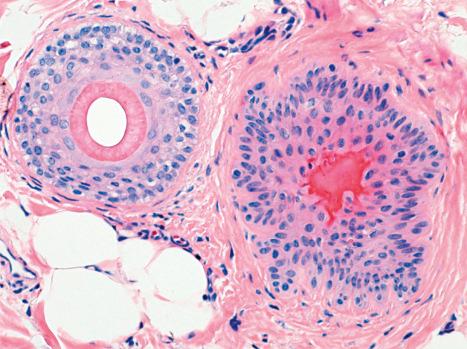
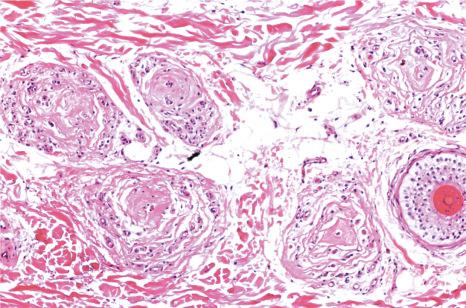
The differential diagnosis of telogen effluvium is mainly with diffuse nonscarring alopecias, including androgenetic alopecia, alopecia areata incognito, and loose anagen hair syndrome.
In androgenetic alopecia, the main histologic feature consists of a zonal pattern of hair loss with miniaturization of hairs. In addition, the gentle hair pull is normal. Hair pluck can be puzzling due to a higher count of hairs in telogen. It is important to remember, however, that in the early stages of androgenetic alopecia, hair follicles more frequently enter telogen. Nevertheless, in telogen effluvium the ratio between terminal hair follicles and vellus hairs remains within the normal range of greater than 7 : 1 and there is no inflammation. In cases when there is overlap with androgenetic alopecia, it is very useful to biopsy two different sites to correlate the findings (focal changes in androgenetic alopecia versus diffuse changes in telogen effluvium) and establish a precise diagnosis. However, it is also important to remember that the two conditions may coexist and that chronic telogen effluvium may uncover occult androgenetic alopecia ( Fig. 22.98 ).
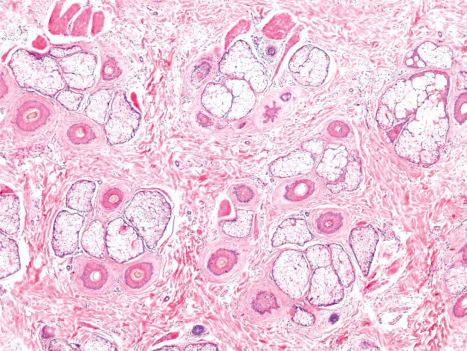
Alopecia areata incognito displays many yellow dots (dilated infundibular openings), numerous hair follicles in telogen, and increased number of miniaturized hairs. Lymphoid infiltration of the hair bulbs is sometimes observed. In contrast, telogen effluvium lacks histologic evidence of inflammation and dilated infundibular openings.
Loose anagen hair syndrome which may occasionally affect adults without a family history can be confused with telogen effluvium. The differential diagnosis is easy, with the hair-pull test showing the majority of the hairs in anagen and the extracted hairs lacking external and internal root sheaths. Short anagen syndrome presents also in blonde girls with short hair; the difference is that the hair that is obtained in the pull test is telogen. Additionally, the patients with short anagen do not improve with age.
Another condition that may present with an excess of telogen hair follicles, (with number counts near 50% or more) is trichotillomania. Nevertheless, in this latter disorder, the stellae and telogen germinal units present melanin debris, in addition to the other findings such as pigmented casts and trichomalacia ( Fig. 22.99 ).
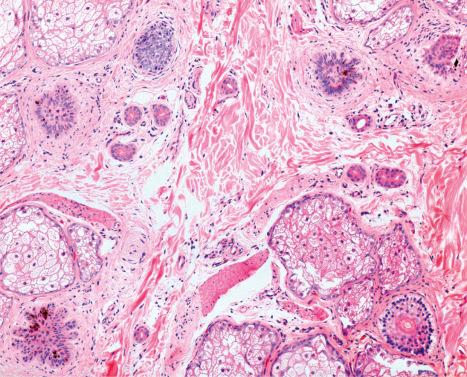
Anagen effluvium usually refers to extensive shedding of anagen hairs due to abrupt interruption of mitotic activity in hair matrix cells. It generally presents in a diffuse manner although with diverse patterned hair loss.
It is typically induced by the administration of antineoplastic drugs, particularly alkylating agents, and low-dose radiation exposure, but has also been documented with some toxins (boric acid, copper, cadmium, mercury, bismuth, thallium), seeds of the selenium-rich plant Lecythis ollaria (coco de mono), and in inflammatory diseases such as alopecia areata and pemphigus vulgaris. The hair loss occurs in the second or third week during which the drug has been administered. It presents as broken off rather than shed hairs and may affect other hair areas such as the beard, eyebrows, eyelashes, axillae, and pubic hair. Once the medication is stopped, the loss is usually reversible, although permanent alopecia after high busulfan therapy in recipients of bone marrow transplantation, taxanes for breast cancer, and cisplatin and etoposide for lung cancer has been reported. Not all drugs produce anagen effluvium; nevertheless, some like retinoids, 5-fluorouracil and methotrexate trigger telogen effluvium.
The diagnosis is commonly established on the basis of clinical correlation. There are no large histologic studies of the acute phase of anagen effluvium related to chemotherapy. There are only limited studies of patients with permanent alopecia postchemotherapy. The biopsy does not show characteristic changes, and the histologic picture may closely simulate a nonscarring alopecia, an advanced androgenetic alopecia, or a late alopecia areata without an inflammatory cell infiltrate. The utility of the biopsy lies in the differential diagnosis with the aforementioned entities, but more often than not, it may be impossible to reach a correct diagnosis if an appropriate clinical history is lacking.
Loose hair syndrome or loose anagen hair is a noninflammatory, nonscarring form of hair loss. It was first described in 1984 by Zaun as a variant of hair dysplasia in which hair can be easily pulled out. The actual name was introduced simultaneously by Hamm and Price in 1989.
The disease, which usually presents in female children between the ages of 2 and 5 years, is characterized by very fine hair that can be removed without pain. The hair does not grow and therefore does not need to be cut. In the majority of patients, the disease develops spontaneously and improves with age. In a minority of cases, an autosomal dominant mode of inheritance has been described with variable expression and incomplete penetrance. Affected females characteristically have blond hair ( Fig. 22.100 ). The disease has also been documented in boys with black hair of Egyptian, Indian, or African descent.
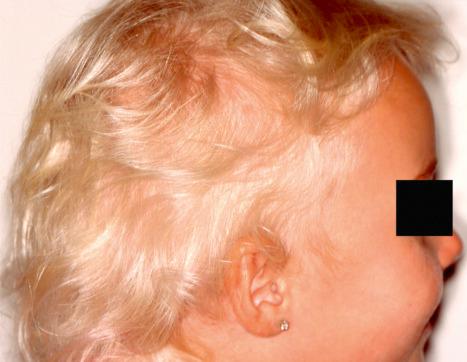
If the hair is pulled out, regrowth may be normal or very slow. Washing and light brushing induce shedding. There is no involvement of the hair of the eyebrows, eyelashes, or on any other part of the body. The disease improves with age as the hair increases in caliber, density, and length. However, a tendency to anagen hair loss persists indefinitely. The phenotype is heterogeneous, and in some patients with no family history the onset of the disease is in adult life. Such cases are often misdiagnosed as telogen effluvium. There are three phenotypes: type A, which shows decreased hair density; type B, which is characterized by unruly and curly hair; and type C, which has normal hair density. Types A and B occur in children, possibly evolving into the type C phenotype around the age of 8 years.
Diagnosis is relatively easy with a hair-pull test or a trichogram. The hairs loosen without any effort, just by soft traction. The diagnosis is confirmed by microscopic examination, demonstrating that the majority (more than 70%), if not all, the hairs are in anagen. Adherence to the follicle is so poor that the extracted hairs lack inner and outer root sheaths. The hair cuticle shows some folding (ruffled cuticle) ( Figs 22.101 and 22.102 ).
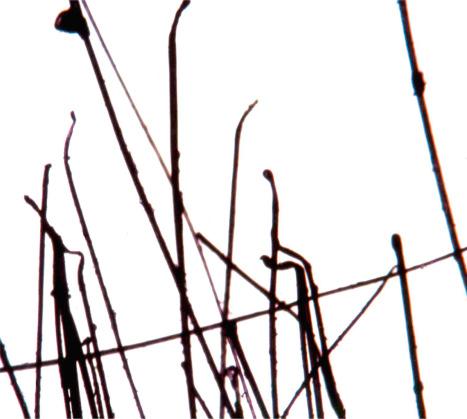
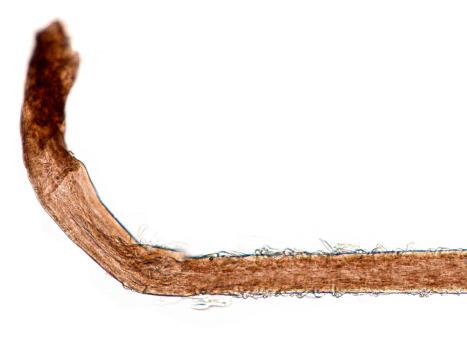
It is important to bear in mind that the hair-pull test varies according to the age of the patient, and in children aged 10 years or under it is quite normal to find a high percentage of anagen hairs. However, in loose anagen hair syndrome the percentage is much higher and the hairs have absent inner and outer root sheaths. One also must bear in mind that the number of hairs in anagen obtained with the hair-pull test may vary over time; hence, a single negative hair-pull test does not exclude the diagnosis.
Loose anagen hair syndrome has been associated with Noonan syndrome, Moyamoya disease, epidermolysis bullosa simplex, Dowling-Meara type, trichotillomania, alopecia areata, hypohidrotic ectodermal dysplasia, ocular colobomata, macular dystrophy, spun-glass hair, and woolly hair.
The cause of loose anagen hair syndrome appears to be a mutation of keratins K6HF and K6IRS. K6HF is a type II cytokeratin found solely in the companion layer associated to Henle layer. K6IRS is specific for the inner root sheath of the hair follicle. The mutations lead to premature keratinization of the inner root sheath and poor adhesion of the cuticle of the hair shaft to the cuticle of the internal root sheath, resulting in premature cessation of the anagen phase.
Histologic examination reveals no consistent morphological abnormalities except for fragmentation of the inner root sheath, with clefts between the inner root sheath and hair shafts and between the inner and outer root sheath probably as a result of the abnormal composition and keratinization of the inner root sheath with loss of its anchoring properties. However, this histologic feature may also be seen in biopsies from normal patients without alopecia as a consequence of processing artifact.
The differential diagnosis of loose anagen hair syndrome is mainly with diffuse nonscarring alopecias such as diffuse alopecia areata, telogen effluvium, and short anagen hair syndrome. This is usually an easy task and can be done on clinical grounds alone or with the aid of a gentle hair-pull test or a biopsy. Alopecia areata may be confused with loose anagen hair syndrome due to the presence in the trichogram of numerous dystrophic anagen hairs. In these cases, a biopsy may be useful to show the presence of lymphocytes in the hair bulbs in alopecia areata. Histologically, loose anagen hair syndrome lacks inflammation. Distinction from telogen effluvium is easy if a gentle hair-pull test shows only hairs in telogen. In short anagen syndrome, the pull test and trichogram only show short telogen hairs.
Short anagen syndrome was described by Kersey in 1987 in a patient with trichodental syndrome. It is a congenital disease characterized by short fine hair from birth due to a decrease in the duration of anagen. In the most frequent presentation, the hair does not grow longer than the neck and never needs cutting. The majority of the cases have been described in Caucasian women with blonde hair. Some cases of short anagen have been described in African-American patients and Caucasian patients with brown hair and one in an Asian patient. Short anagen syndrome has been associated with trichodental syndrome and congenital hypotrichosis.
As the anagen phase is shortened, there is an increase in the number of hair follicles in telogen. Family groupings have been described suggesting an autosomal dominant hereditary pattern. Clinically, the hair is normal but there is an increase in the number of hairs obtained in a pull test.
Short anagen syndrome is a form of hair growth defect due to a shortened anagen phase; consequently, there is an increase in the hair follicles that enter telogen phase. The cause of this phenomenon is unknown.
A diagnosis is usually easy to make based on clinical features and a trichogram or pull test. The trichogram reveals a reduction in the ratio of anagen/telogen hairs due to a decrease of the follicles in anagen. The pull test is positive for hair in telogen. Usually, it is not necessary to perform a biopsy as the findings are unspecific.
The most important differential diagnosis is with loose anagen syndrome. This also presents in blonde girls with short hair that does not grow. The most important difference is that the hairs obtained in the pull test are in telogen, not in anagen. Furthermore, patients with loose anagen syndrome improve with age, whereas in those with short anagen the abnormality persists.
Syphilitic alopecia is a nonscarring variant of alopecia that has resurfaced in recent years, particularly in association with HIV infection.
The clinical manifestations of syphilitic alopecia were divided into two groups by McCarthy in 1940:
Symptomatic syphilitic alopecia, which is associated with other manifestations of secondary syphilis, is the rarest form of alopecia. The hair loss may affect the scalp or any other hair-bearing area of the body. It can present in a diffuse or localized pattern ( Figs 22.103 and 22.104 ).
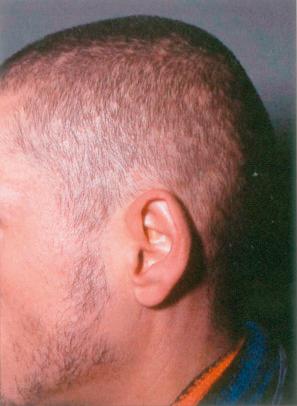
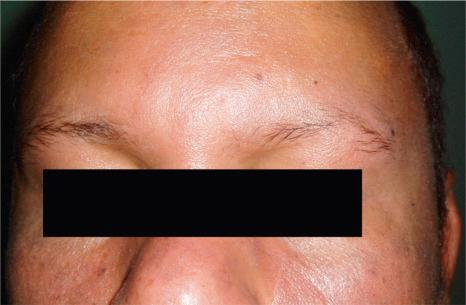
Essential syphilitic alopecia with no other features of secondary syphilis. This may also be diffuse or localized and represents a variant of latent syphilis. Three clinical forms have been described: moth eaten, which is the most frequent and presents usually in the occipital zone, diffuse, which corresponds to telogen effluvium as a reactive phenomenon and a mixed form.
Patients with symptomatic syphilitic alopecia have other manifestations of secondary syphilis and the diagnosis is usually easy. Patients with essential syphilitic alopecia are asymptomatic, and a high degree of suspicion is essential to achieve a correct diagnosis. Alopecia as a manifestation of secondary or latent syphilis has been reported to occur with an incidence varying between 2.9% and 12.5%. Therefore, a serological test for syphilis should be considered when there is hair loss for which a satisfactory explanation is not apparent.
It is important to bear in mind that syphilitic alopecia can involve the whole body and also occasionally present as localized disease at sites away from the scalp. Alopecia syphilitica has been described in a neonate with congenital syphilis and in accelerated form as a complication of the Jarisch-Herxheimer reaction.
Clinically, symptomatic and essential syphilitic alopecia are very similar and can only be differentiated by the presence of papulosquamous lesions on the scalp or other areas of the body in the symptomatic variant. In both forms, the patches of alopecia present with a characteristic ‘moth-eaten’ appearance.
The clinical differential diagnosis of syphilitic alopecia is very broad, and the ‘moth-eaten’ alopecia pattern can be confused with trichotillomania, traction alopecia, or alopecia areata. The diffuse variant may be confused with telogen effluvium and a diffuse type of alopecia areata.
The trichogram and the hair-pull test show an increase in the number of telogen hairs in the affected areas.
The histologic findings in the lesions of symptomatic syphilitic alopecia are similar to those of secondary syphilis occurring elsewhere. In the papulosquamous lesion, there is psoriasiform hyperplasia of the epidermis, spongiosis and exocytosis of neutrophils, and focal interface change with hydropic degeneration of basal cells. Lymphocytes and plasma cells are present at the dermal–epidermal junction. In the dermis, there is a superficial and deep perivascular and periadnexal lymphohistiocytic inflammatory cell infiltrate with a variable number of plasma cells and occasionally a granulomatous infiltrate in the upper dermis ( Fig. 22.105 ).
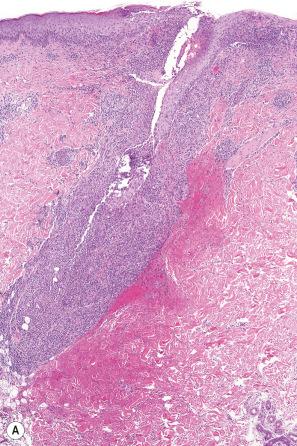
Essential syphilitic alopecia is characterized by less prominent epidermal changes, reduced anagen hairs, increased telogen and catagen hairs, and a bulbar, peribulbar, and peri-isthmic lymphocytic infiltrate with a variable number of plasma cells. Fibrous tracts may also show lymphocyte infiltration. Identification of Treponema pallidum in sections of tissue in biopsies of patients with syphilitic alopecia yields variable results. Immunohistochemistry is more reliable and sensitive than a silver stain ( Fig. 22.105C ). Molecular studies with the polymerase chain reaction may also be useful.
In essential syphilitic alopecia, the histologic features are very similar to those of alopecia areata. The presence of plasma cells and the tendency of the infiltrate to spare the hair bulb and involve the external root sheath at a higher level without eosinophils are helpful diagnostic pointers.
Essential syphilis may also present as a telogen effluvium, and distinction between both these conditions on histologic grounds can be impossible, making serological screening for syphilis essential.
Lipedematous scalp was described by Cornbleet in 1935 as scalp swelling in a black woman without hair loss. The term lipedematous alopecia was first mentioned by Coskey et al. in 1961, in two women of African descent. It is also known as spongy scalp syndrome. It is a very rare form of noninflammatory and nonscarring alopecia of unknown etiology characterized by thickening and swelling of the scalp with diffuse hair loss and typically presents in adult black women with predilection for the vertex and the occipital regions. The disease may have a slowly progressive course. It has been associated with other medical conditions such as skin and joint hyperelasticity, discoid lupus erythematosus, diabetes mellitus, renal failure, Sjögren syndrome, hyperlipidemia, androgenic alopecia, hypertension, nevus lipomatosus, scalp psoriasis, obesity, and with the use of a special tight head covering called ‘Mandil’. A congenital form may also occur. Other cases have been described in a child, white females, Orientals, males, and in a Maori girl.
Occasionally, patients present with edema and bogginess of the scalp in the absence of hair loss (lipedematous scalp). It is not clear whether this condition is part of the spectrum of lipedematous alopecia or a different entity altogether, as patients with lipedematous scalp do not seem to develop hair loss.
The clinical appearance of lipedematous alopecia is characteristic. The hairs are thin, short, broken, and of less than 2 cm in length. A boggy and spongy thickened scalp is more evident on palpation than visually ( Fig. 22.106 ). There may be pain and pruritus in the affected area. The diagnosis can be established by magnetic resonance imaging (MRI), computed tomography (CT) scan, and head ultrasound by demonstrating the irregular thickening of the subcutaneous tissue. The normal scalp thickness varies with age, between 4.8 ± 0.12 mm in women 20 to 39 years of age and 5.6 ± 0.15 mm in women 40 to 69 years of age. In lipedematous alopecia, the scalp thickness varied between 10 and 15 mm. With videodermoscopy, lipedematous scalp shows linear areas of telangiectasia within the scalp creases.
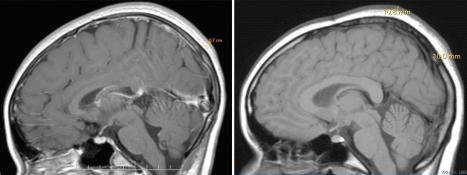
There has been speculation with regard to the role played by thickened adipose tissue, edema, and dilated lymphatic vessels in the development of hair loss. It has been speculated that obesity and hormonal factors may play a role as the majority of patients are women. Leptin may also play a role in the distribution of the fat tissue. At present, the exact pathogenesis of the disease is unknown.
The scalp biopsy must be deep and include the whole thickness of the subcutaneous tissue, reaching the galea, as superficial biopsies may give a false impression of normality. The specimen must be processed with serial vertical sections. The histologic features consist of an increase of almost double the thickness of the scalp, with tissue edema, expansion of the subcutaneous fat, and infiltration of fat into the dermis ( Fig. 22.107 ). In some cases, dilated lymphatic vessels have been observed. Mucin deposition is minimal or absent. Scarring is not present. Electron microscopy demonstrates localized edema with disruption and degeneration of the subcutaneous tissue. In patients with alopecia, there is a mild decrease in the number of hair follicles but, there is no associated inflammation or scarring.
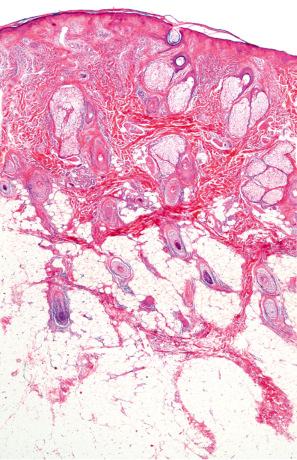
The differential diagnosis includes cutis verticis gyrata and lipoma. Primary cutis verticis gyrata is characterized by redundant skin on the scalp that exhibits typically symmetrical deep furrows, oriented in an anteroposterior direction and with a cerebriform pattern ( Fig. 22.108 ). In contrast to lipedematous alopecia, primary cutis verticis gyrata usually starts after puberty in men and most commonly affects the crown and back of the head. A skin biopsy of the affected area can be normal or display thick connective tissue. Secondary cutis verticis gyrata appears at any age and has been associated with many diseases including inflammatory processes, systemic illnesses, acromegaly, idiopathic hypertrophic osteoarthropathy, benign and malignant tumors including nevi, and chromosomal abnormalities. In these cases, the histology is that of the underlying process. A lipoma of the scalp is a well-circumscribed nodule that grows under the skin. It is surrounded by a capsule and may occur anywhere. It is not associated with alopecia and it does not contain hair follicles.
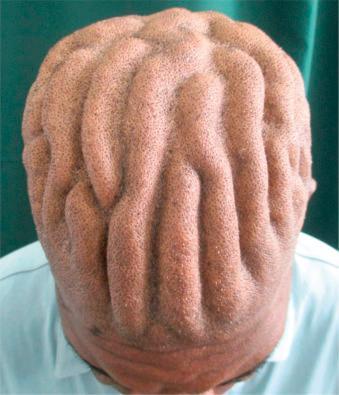
A wide variety of follicular and nonfollicular scalp conditions including hereditary, developmental, and acquired disorders may result in scarring or permanent alopecia as a secondary phenomenon ( Fig. 22.109 ). Permanent alopecia may also take place in the late stages of some nonscarring alopecias such as androgenetic alopecia, alopecia areata, psoriatic alopecia, and traction alopecia (‘transitional scarring or biphasic pattern’ alopecias).
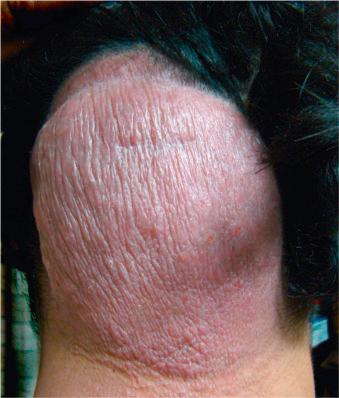
In this section, only those diseases that primarily affect the scalp or involve it secondarily with distinctive clinicopathological features will be described.
Scarring alopecia constitutes one of the most difficult and complex areas in the study of hair disease. It includes a wide variety of nosological entities with different etiologies and distinctive clinical features. However, the characteristic findings are usually only evident in the early stages, and as the disease progresses the clinical and pathological features of different diseases overlap, making categorization often impossible.
Scarring alopecias are characterized by irreversible loss and destruction of hair follicles and hair shafts. There is frequently, but not always, associated dermal fibrosis. Clinical examination reveals absence of follicular ostia (usually in a focal distribution), induration or atrophy of the skin, pigmentary alterations, follicular plugging, and occasionally, follicular pustules ( Fig. 22.110 ). The histopathological hallmark is usually the presence of an inflammatory infiltrate surrounding the bulge and isthmus and loss of sebaceous glands, later followed by the formation of a scar with the hair follicle being replaced by follicular fibrous tracts ( Figs 22.111 and 22.112 ). These fibrous tracts clearly represent scarring and are different to the follicular stellae seen in androgenic alopecia and telogen effluvium. They extend from the epidermis to the deep dermis. They are easy to identify using polarized light ( Fig. 22.113 and see Fig. 22.34 ). Histochemical stains including elastic stain and trichrome are useful to define the scarring areas and in the differential diagnosis with discoid lupus erythematosus, lichen planopilaris, and pseudopélade of Brocq ( Fig. 22.114 ). Sometimes the only structure left of the hair follicle is the arrector pili muscle ( Fig. 22.115 ).
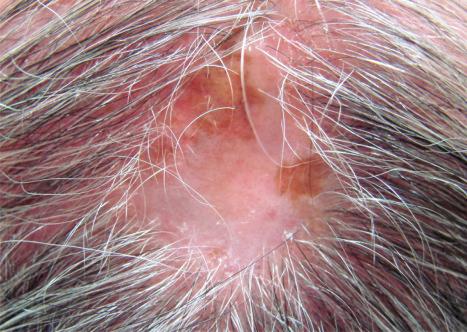
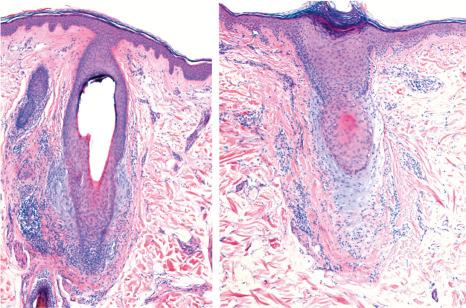
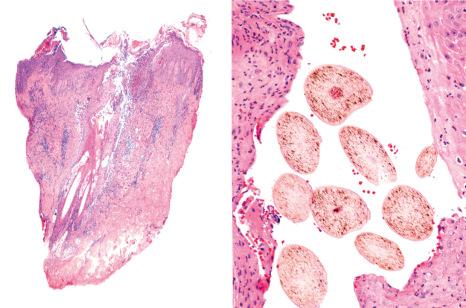
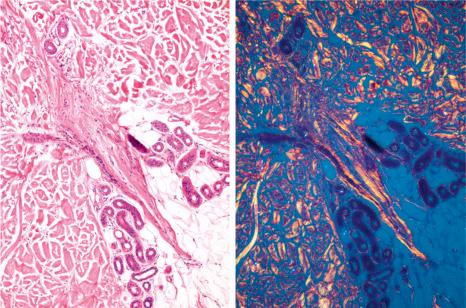
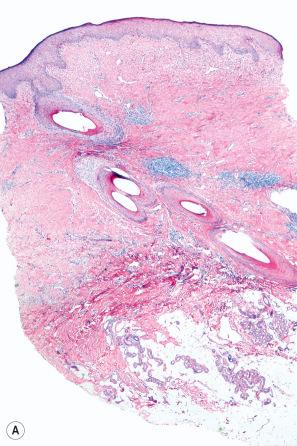
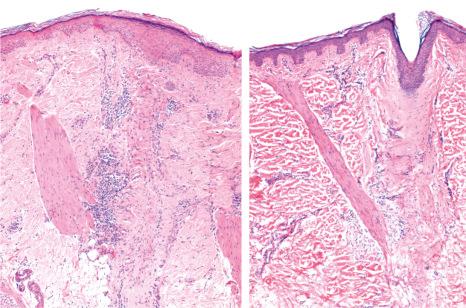
From the point of view of clinical management, scarring alopecia represents a real ‘trichologic emergency’ because in a short period of time the hair follicles may be permanently destroyed. The resulting alopecia is irreversible and has a significant psychological impact. As the treatment is guided by the histopathologic findings, a scalp biopsy should be the first step in management.
Scalp biopsy is the most important test to achieve the diagnosis in all cases of primary scarring alopecia. These should be taken from the active border. Multiple biopsies may be necessary to reach a definitive diagnosis. Ideally, vertical and horizontal sections should be examined stained with hematoxylin and eosin, PAS, and elastic tissue stains. The use of horizontal and vertical sections yields the higher results as it enables the pathologist to evaluate the type and location of the inflammatory infiltrate, the presence or absence of fibrosis, the morphology of the hair follicles, and their stage in the cycle ( Fig. 22.116 ; see Fig. 22.112 ). In advanced cases in which only a scar without inflammatory infiltrate or hair follicles is present, direct immunofluorescence evaluation may be of great help in the differential diagnosis between discoid lupus erythematosus, lichen planopilaris, and pseudopélade of Brocq. For immunofluorescence studies, the second half of the punch biopsy submitted for vertical sections may be used (see Fig. 22.9 ).
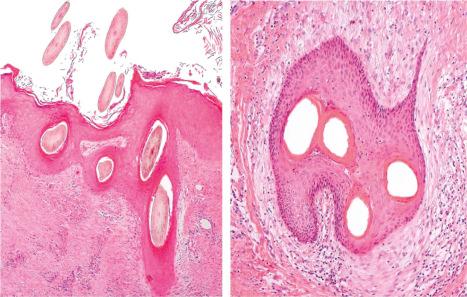
It is important not to forget that the evaluation of patients with scarring alopecia requires very close clinicopathological correlation, detailed clinical history, and laboratory tests including serology for syphilis, direct Gram and PAS stains, and culture of the lesions.
The pathophysiology of scarring is unclear and varies according to the different processes that result in permanent hair loss. However, some unifying generalizations concerning alterations on the stem cell-rich region in the bulge, the sebaceous gland, and the outer root sheath have emerged.
In many of the diseases that cause scarring alopecia, the inflammatory infiltrate is concentrated around the upper part of the hair follicle, involving the bulge and, as a consequence, the stem cells ( Fig. 22.117 , see Fig. 22.111 and 22.112 ). This damages the regenerative capacity of the hair follicle. The damage may be physical or by inhibition of the function resulting in interference in the interaction between hair follicle mesenchymal cells and the bulge epithelium. The hair follicle cycle is abolished. The retained hair shaft bursts the bulb and lies free in the dermis, inducing a strong granulomatous inflammatory response with scarring ( Figs 22.118 and 22.119 ). The only case in which the inflammatory infiltrate surrounds the bulge is in dissecting cellulitis of the scalp (perifolliculitis capitis abscedens et suffodiens), where the infiltrate is very deep at the limit between the dermis and the subcutaneous tissue.
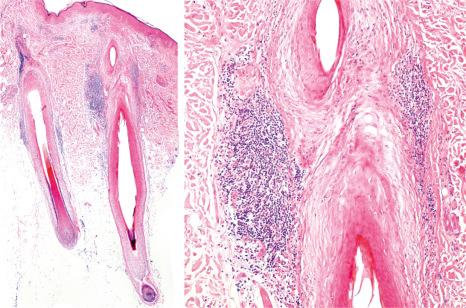

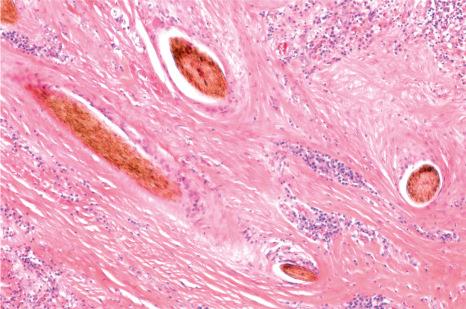
Another common associated marker of scarring alopecia is early loss of sebaceous glands. This observation has been extensively studied in the asedia variant of mutant mice that lacks a gene to make sebum, has hypoplastic glands, and rapidly develops scarring alopecia. It appears therefore that the localization of the infiltrate at the upper part of the hair follicle, including the bulge, is crucial to the development of permanent damage.
There are as many classifications of scarring alopecias as there are authors who have written about the subject.
In view of the fact that many primary scarring alopecias have clinical and histologic features in common, distinction between different clinical variants is often very difficult. Due to this, it has been proposed that primary cicatricial alopecia be separated in groups (lymphocytic, neutrophilic, mixed, and non-specific), based on the type of infiltrate that predominates within and around the affected hair follicles ( Table 22.4 ).
| Lymphocytic |
| Chronic cutaneous lupus erythematosus |
| Lichen planopilaris |
| Classic lichen planopilaris |
| Frontal fibrosing alopecia |
| Graham-Little syndrome |
| Classic pseudopelade (Brocq) |
| Central centrifugal cicatricial alopecia |
| Alopecia mucinosa |
| Keratosis follicularis spinulosa decalvans |
| Neutrophilic |
| Folliculitis decalvans |
| Dissecting cellulitis/folliculitis (perifolliculitis capitis abscedens et suffodiens) |
| Mixed |
| Folliculitis (acne) keloidalis |
| Folliculitis (acne) necrotica |
| Erosive pustular dermatosis |
| Nonspecific |
* Olsen, E.A., Bergfeld, W.F., Cotsarelis, G. et al. (2003). Workshop on Cicatricial Alopecia. Summary of North American Hair Research Society (NAHRS)-sponsored Workshop on Cicatricial Alopecia. J Am Acad Dermatol , 48 , 103–110.
This classification was proposed at the first consensus meeting on cicatricial alopecia held at Duke University in North Carolina (2001) by the North American Hair Research Society (NAHRS). It has gained wide acceptance and thus, it will be taken as the basis for this chapter.
This group of scarring alopecias is characterized by a lymphocyte infiltrate that always affects the superior segment of the follicle around the bulge. In general, the infiltrate does not change unless the follicle ruptures, giving place to a granulomatous reaction. There is loss of the sebaceous glands and fusion of hair follicles in numbers of two to a maximum of three. This fusion must be differentiated from that frequently observed in normal hair follicles at the infundibular level, hence the evaluation of a scarring alopecia must be done at the level of the isthmus or deeper ( Fig. 22.120 ; see also Figs 22.17 and 22.46 ).
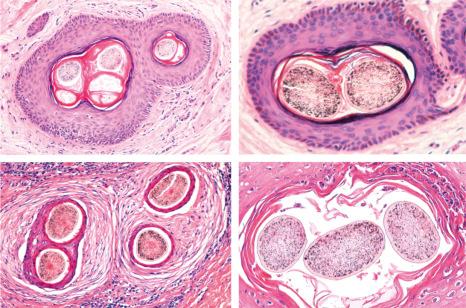
About 30–50% of patients with discoid lupus erythematosus present with scalp involvement. Women are more frequently affected than men, and the disease rarely progresses to SLE. Patients with SLE have cutaneous involvement in approximately 70% of cases. Of these, a high percentage show some degree of scalp involvement with alopecia during the course of the illness.
The alopecia associated with lupus erythematosus may manifest as nonscarring and scarring forms. The nonscarring form has two variants: the first shows clinical and histologic features similar to those of common telogen effluvium, whereas the second presents with patchy areas of hair loss that can simulate alopecia areata or syphilitic alopecia and occurs in patients who usually have severe SLE. Clinically, erythema and edema in the involved areas are sometimes evident. These two nonscarring variants of alopecia are reversible when the primary illness is treated. The scarring form of lupus erythematosus-associated alopecia is typically seen in patients with the discoid variant and frequently occurs in adults, particularly women. Although it may also occur in SLE, this is infrequent. Scalp involvement is similar to that seen at other sites and consists of erythema, atrophy, follicular plugging, hyper- and hypopigmentation, and hair loss ( Fig. 22.121 ). Contrary to other types of scarring alopecia, these changes are observed in both the periphery and the center of the lesion ( Fig. 22.122 ). The lesions, which can be solitary or multiple, small or confluent large plaques, may progressively affect extensive areas of the scalp ( Fig. 22.123 ).
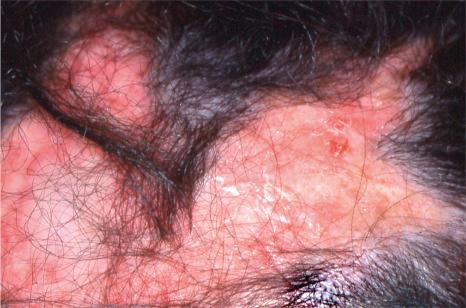
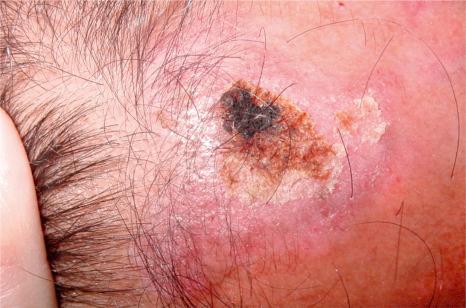
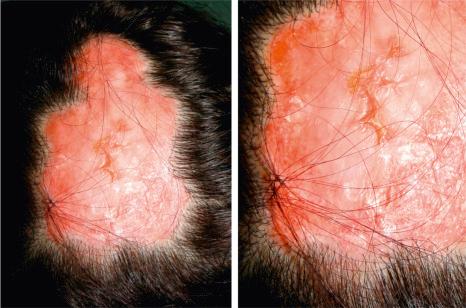
As the illness progresses, the similarity to pseudopélade of Brocq and lichen planopilaris becomes more pronounced ( Fig. 22.124 ). Discoid lupus erythematosus may present with loss of the eyebrows or eyelashes (madarosis) in the absence of involvement of the scalp. In patients with discoid lupus erythematosus the incidence of alopecia areata is increased and, in longstanding disease, squamous cell carcinoma may rarely ensue.
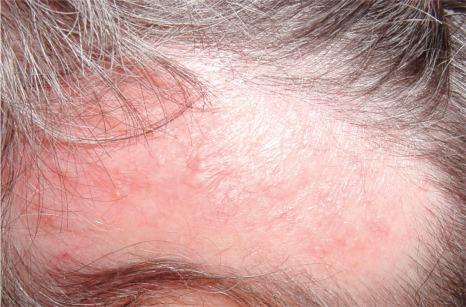
A rare form of lupus panniculitis with involvement of the lower part of the hair follicle and a transitory form of alopecia similar to alopecia areata have been documented. Another rare form of linear alopecia related to lupus erythematosus profundus following the lines of Blaschko has been recognized. Lipedematous alopecia has been associated with discoid lupus erythematosus. The disease has also been associated with chronic granulomatous disease, frontal fibrosing alopecia, Parry-Romberg syndrome, and cutaneous horns.
The pathogenesis of lupus affecting the scalp is identical to that occurring at other sites of the body. The most appropriate site for the biopsy is best selected through dermoscopy of the affected areas of the scalp.
Scalp involvement by lupus erythematosus equally affects the hair follicle and the epidermis at the dermal–epidermal junction. For this reason, vertical sections are preferred in the histologic study of the condition. However, if two biopsies can be obtained, a combination of vertical and horizontal sections for histologic interpretation and direct immunofluorescence is ideal.
The histologic appearances of alopecia in lupus erythematosus are as varied as the clinical forms.
In the nonscarring variants, the chronic telogen effluvium-like form shows features identical to common telogen effluvium. The biopsy and trichogram both show a net increase in the number of telogen hair follicles.
In the variant with patchy alopecia, the histologic findings are very similar to those seen in alopecia areata and syphilitic alopecia except that the inflammatory infiltrate is generally more prominent and deep in lupus erythematosus ( Fig. 22.125 ). Furthermore, other findings more typical of lupus erythematosus, including dermal mucin deposition and focal hydropic degeneration of the follicular epithelium, are often present. The diagnosis in patients with systemic disease is generally straightforward, as symptoms and signs of systemic disease and typical laboratory findings are usually evident.
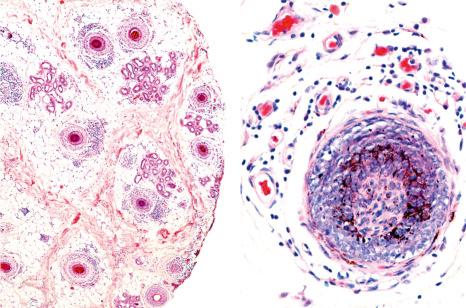
In the scarring variant, the microscopic findings differ little from those found in cutaneous discoid lupus presenting elsewhere. The degree of perifollicular inflammation, however, tends to be more intense than that seen in discoid lesions at other cutaneous sites ( Fig. 22.126 , see Fig. 22.7 ). In some cases, there may be intense hydropic degeneration of basal cells with minimal inflammation, whereas in others the features are those of a typical lichenoid dermatitis ( Fig. 22.127 ). Colloid bodies are often present but they are less abundant than in lichen planopilaris. The presence of mucin and an infiltrate of plasma cells in a perivascular or periadnexal location are strong pointers toward a diagnosis of discoid lupus erythematosus ( Fig. 22.128 ). Other histologic features that may also be seen include epidermal atrophy with hyperkeratosis and follicular plugging, thickening of the basement membrane, highlighted with the PAS stain with or without diastase, telangiectasia, and edema ( Fig. 22.129 ). An inflammatory infiltrate within the fibrous stellae deep to the hair follicles may sometimes be present simulating alopecia areata and syphilitic alopecia.
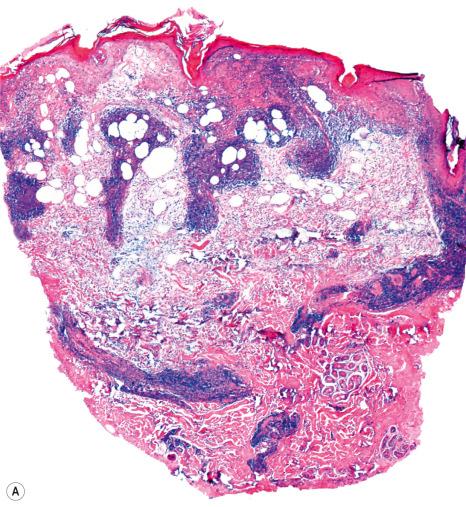
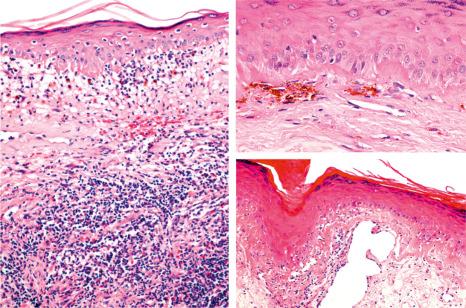
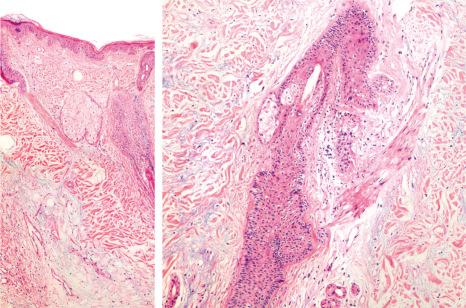
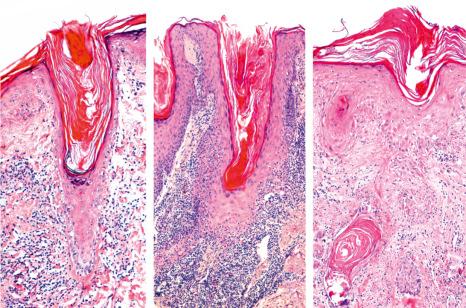
As is typical of other scarring alopecias, the inflammatory cell infiltrate in discoid lupus is particularly prominent around the mid portion of the hair follicle at the level of the sebaceous glands, which eventually disappear ( Fig. 22.130 ). The location is important because of the resulting reduction in the number of stem cells. Nevertheless, in longstanding lesions the inflammatory cell infiltrate may almost completely disappear, leaving only fibrosis and atrophy ( Fig. 22.131 ). In these cases, staining for elastic fibers will underscore the loss of elastic tissue within the broad scarred areas of the dermis and destruction of the elastic sheath surrounding the fibrous tracts (see Fig. 22.114 ).
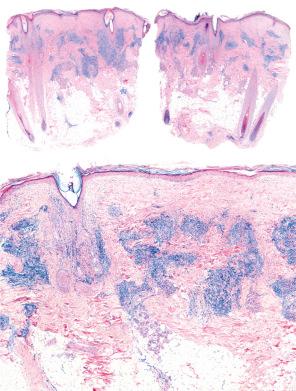
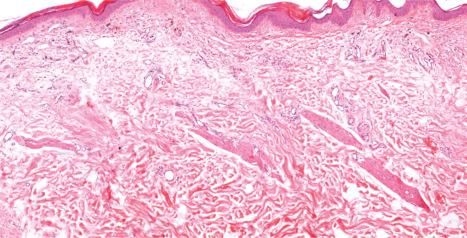
The two most important differential diagnoses include lichen planopilaris and pseudopélade of Brocq.
Clinically, in lichen planopilaris hyperkeratotic lesions are located at the periphery of the areas of alopecia as opposed to lupus erythematosus where the follicular hyperkeratosis is constantly present in the central part of the bald patches. Histologically, the dermal–epidermal interface change in discoid lupus erythematosus is usually pronounced and of vacuolar type, whereas in lichen planopilaris lichenoid features (i.e., a more bandlike inflammatory cell infiltrate) predominate around the hair follicle. Additional histologic features that help in the diagnosis of lupus erythematosus are the more prominent perivascular infiltrate, the presence of dermal mucin, and plasma cells.
The histologic diagnosis distinction from pseudopélade of Brocq is based on the absence of marked inflammation, significant follicular plugging, thickened basement membrane, and basal vacuolar degeneration in lupus erythematosus. Pseudopélade of Brocq is characterized by white-ivory colored patches of alopecia limited to the scalp, with a ‘footprints in the snow’ appearance.
In histopathologically inconclusive cases, direct immunofluorescence is an important tool in the differential diagnosis of discoid lupus erythematosus. A positive lupus band test is seen in up to 83% of cases and consists of granular deposits of IgG, C3, and C1q at the level of the basement membrane, both at the dermal–epidermal junction and at the junction between the follicular epithelium and the dermis. A negative result does not completely exclude the possibility of discoid lupus erythematosus. In lichen planopilaris, direct immunofluorescence shows globular deposition, particularly of IgM at the junction between the follicular epithelium and the dermis, highlighting apoptotic bodies. Linear deposition of Ig along the follicular basement membrane region, however, may also be seen. Direct immunofluorescence in pseudopélade of Brocq is usually negative. It seldom shows finely granular IgM deposition along the follicular infundibular basement membrane. Finally, another recent important finding that may help in the differential diagnosis is the presence of groups of CD123+ plasmocytoid dendritic cells (defined as clusters of at least five cells) in discoid lupus whereas in lichen planopilaris these cells are arranged as single interstitial cells.
Lichen planopilaris includes several variants with similar clinical, histopathological, and immunohistopathological features: classic lichen planopilaris, frontal fibrosing alopecia, fibrosing alopecia in a pattern distribution, and Graham-Little syndrome.
Classic lichen planopilaris is a very common form of scarring alopecia first described by Pringle in 1895. It is characterized by a variable clinical course resulting in patchy areas of hair loss accompanied by follicular inflammation. It is more frequent in women (70%) and has an average age of onset of 51 years. It has occasionally been reported in children. Approximately 50% of the patients have typical lesions of lichen planus elsewhere on the skin at one time or another. Typical lichen planus associated with lichen planopilaris of the scalp is rarely observed. However, involvement of the nails and oral/vulval mucosae may also be seen.
Common clinical symptoms include itching, scaling, tenderness, and burning sensation. Physical examination shows variable changes depending on the stage of clinical evolution. The lesions may be single or multiple and usually involve the parietal and vertex areas of the scalp. In general, the findings result from a mixture of inflammatory changes and scarring. The inflammation is characterized by follicular keratotic papules, scaling, and perifollicular erythema (see Fig. 22.110 ). The scarring results in hair loss with dilated follicular ostia containing keratotic debris ( Fig. 22.132 ). Several hair shafts may emerge through these dilated ostia, generally in a number lower than 3. If examination of the scalp is performed at a late stage of the disease, overlap with other scarring alopecias is common, particularly pseudopélade of Brocq. The resemblance is such that some authors claim that these two entities represent the same illness.
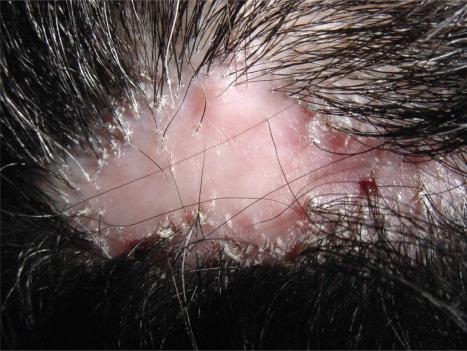
In the active stages, the hair-pull and hair-pluck tests show an increase in the number of anagen hairs. The most useful laboratory tests other than biopsy include direct immunofluorescence and antibody screening to exclude discoid and SLE.
Occasionally, lichen planopilaris may present in areas such as the extremities, trunk, and vulva, without involvement of the scalp. Exceptionally, a facial and truncal linear distribution has been documented, following Blaschko lines. Another variant of lichen planus that may affect the adnexal structures is lichen planus poritis (lichen planus of the eccrine glands), which involves the acrosyringium and proximal eccrine ducts in the superficial part of the dermis.
Lichen planopilaris has been associated with exposure to gold, autoimmune thyroiditis, psoriasis, scleroderma en coup de sabre, dermatitis herpetiformis, erythema dyschromicum perstans, scalp trauma, and break dancing. The disease has also been reported restricted to an epidermal nevus, in association with etanercept and imiquimod treatment, following whole brain irradiation and after hair transplantation and facial cosmetic surgery.
Although the pathogenesis of lichen planopilaris is similar to that of lichen planus occurring elsewhere, several differences have been reported.
Lichen planopilaris is considered a hair-specific autoimmune disease in which activated T lymphocytes target follicular antigens, mainly the epithelium of the infundibulo-isthmic region (the bulge area). In the majority of cases it does not affect the hair bulb or the dermal–epidermal interface. The antigen targeted in this response is unknown. Lichen planopilaris has been associated with an increased frequency of HLA DRB1*11 and DQB1*03 alleles.
Some studies have shown an increment in the number of CD8+ T cells compared with the CD4+ T-cell population and a decrease in proliferative bulge stem cells. The latter favors a cell-mediated cytotoxic immune response in the pathogenesis of the disease. Nevertheless, a further study has shown low numbers of CD8+ T cells in ‘early’ active stages of the disease and in the late ‘fibrotic’ phase, preservation of the bulge stem cells. This suggests that the irreversible loss of hair follicles bulge cells is not necessarily a consequence of T cell-mediated destruction. A further significant finding in the etiopathogenesis of lichen planopilaris has been the observation of an altered distribution of integrins in the affected follicular keratinocytes, facilitating loss of adhesion of follicular keratinocytes to the stroma. This could also explain the artifactual clefts observed in histologic studies and the phenomenon of easy plucking of the hair in the more active lesions of the disease.
Lichen planopilaris is considered a true trichologic emergency in which treatment should be instituted promptly to avoid irreversible hair loss. In this context, the biopsy is an essential component of the diagnostic work-up. It is very important to take an adequate biopsy from an active lesion, preferably from an area that is erythematous and scaly and in which there are still hair follicles that could be easily plucked, with anagen-like hair roots. This affords the best opportunity of identifying the diagnostic features. A biopsy of a nonactive or burned-out area usually does not offer much information and leads to a diagnosis of end-stage scarring alopecia of undetermined etiology.
The histologic study should include an examination of horizontal and vertical sections, ( Fig. 22.133 ). However, horizontal sections provide particularly valuable information, as the infiltrate is limited mainly to the infundibulum and isthmic region of the hair follicle. Typical findings consist of a lichenoid tissue reaction with formation of apoptotic bodies within the follicular epithelium but with little involvement of the intervening epidermis. Perifollicular fibrosis facilitates a tendency for the follicles to fuse creating an ‘owl eye’ appearance ( Fig. 22.134 and see Fig. 22.117 ). The lower portion of the hair follicle and the bulb are usually not affected, but in severe cases the inferior segment and the suprabulbar zone may be involved These changes are uneven according to disease progression and provide more information in the active and early-stage disease process. Lichen planopilaris does not usually show the classic bandlike infiltrate seen in ordinary lichen planus.
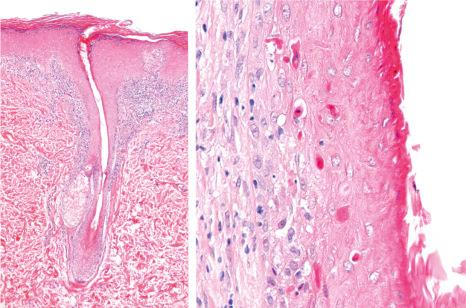
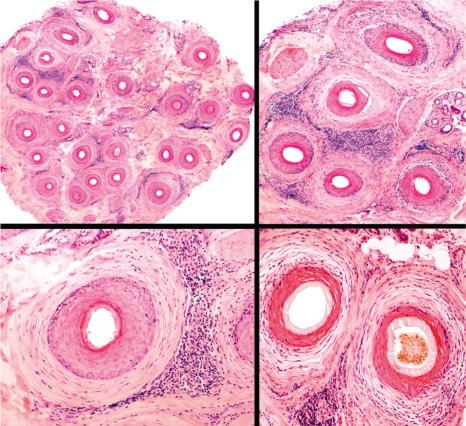
The interface changes are characterized by focal loss of attachment between the follicular epithelium and the surrounding dermis. As a result, artifactual clefts are sometimes apparent and colloid bodies are often found. An associated mononuclear inflammatory cell infiltrate is present within the perifollicular connective tissue sheath, which is usually thickened ( Fig. 22.135 ). Basal follicular keratinocytes in the involved area become squamotized with larger size, prominent eosinophilic cytoplasm, and cytoplasmic angulation ( Fig. 22.136 ). Although mucinous perifollicular fibroplasia may be observed around the follicle, there is no accumulation of dermal mucin ( Fig. 22.137 , see Fig. 22.111 ).
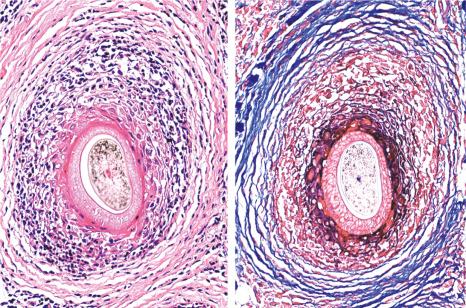
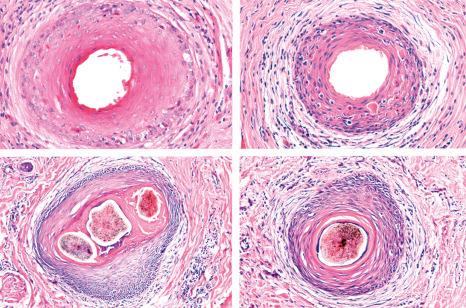
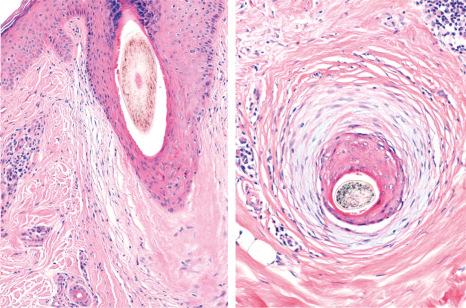
In the late stages, the hair follicle is completely destroyed and replaced by a sclerotic collagenous follicular scar with loss of sebaceous glands. The only structures left are the arrector pili muscles (see Fig. 22.115 ). On occasions, the predominant pattern is that of foreign body granulomas distributed around the free hair shafts ( Fig. 22.138 ). Other forms of scarring alopecia (including pseudopélade of Brocq and discoid lupus erythematosus) share this end-stage histologic appearance. In order to highlight the presence of scarring tissue, special stains to delineate elastic fibers are particularly useful. They allow distinction between normal dermis and scarred areas, as the latter lack elastic fibers. A perifollicular and superficial wedge-shaped scar with loss of the elastic sheath surrounding fibrous tracts is identified, although occasionally it may be seen in other scarring alopecias ( Fig. 22.139 ) .
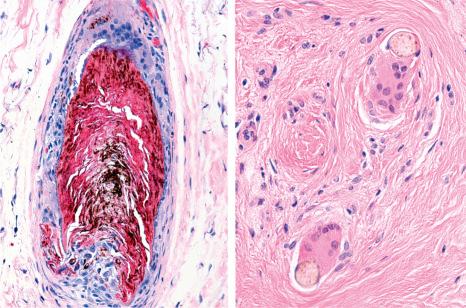
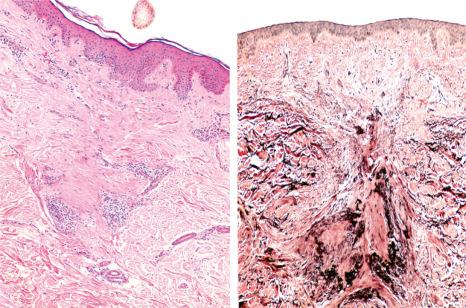
Immunofluorescence studies show staining of colloid bodies with IgM and IgA and linear deposits of fibrin along the basement membrane of the infundibular portion of the hair follicle. Linear deposition of immunoglobulin (usually IgG or IgA) restricted to the follicular epithelium has also been described. However, these immunofluorescence findings are not specific to lichen planopilaris and they may also be observed in other diseases with interface change and damage to the basal cell layer. Increased birefringence within the fibrous tracts is a frequent finding in lichen planopilaris but may occasionally be found in other scarring and nonscarring alopecias (see Fig. 22.113 ) .
The correct diagnosis may be reached in the majority of the cases by careful correlation of histopathological, clinical, and immunohistopathological findings. The most important entities to consider in the differential diagnosis are discoid lupus erythematosus and pseudopélade of Brocq.
In discoid lupus erythematosus, the typical findings include a superficial and deep perivascular lymphohistiocytic infiltrate, dermal mucin, and vacuolar interphase change affecting not only the follicles but also the intervening dermal–epidermal junction. In lichen planopilaris, the infiltrate is mainly seen around hair follicles, and interface change of the interfollicular epidermis is rarely present.
Pseudopélade of Brocq presents as progressive patches of scarring alopecia, and histologically the changes are essentially those of marked scarring with no interface change. It is possible that pseudopélade of Brocq represents a late stage of various forms of scarring alopecia, including lichen planopilaris.
In the end stages of the disease, it may be impossible to differentiate lichen planopilaris from pseudopélade of Brocq and discoid lupus erythematosus. The presence of a band of fibrosis in the papillary dermis accompanied by fibrous tracts in the reticular dermis following the path of destroyed follicles appears to be a valuable pointer toward ‘burn-out’ lesions of lichen planopilaris.
Kossard first described frontal fibrosing alopecia in 1994 as a variant of scarring alopecia closely related to lichen planus and affecting mainly postmenopausal women (postmenopausal frontal fibrosing alopecia). However, some cases have been reported in premenopausal women as well as on the sideburns and beard in males and in patients of African descent. Furthermore, some cases in children and adolescents have also been described.
It presents with progressive and symmetric recession of the frontal hairline associated with smooth and pale skin. Sometimes perifollicular erythema, follicular keratinization, and extension onto the temporal and parietal zones may be observed ( Fig. 22.140 ). In addition, there is loss or reduction of the hair follicles of the eyebrows, the rest of the face, and also of the extremities, axillae, trunk, and pubis ( Fig. 22.141 ). Eyebrow alopecia is thought to precede the scalp alopecia.
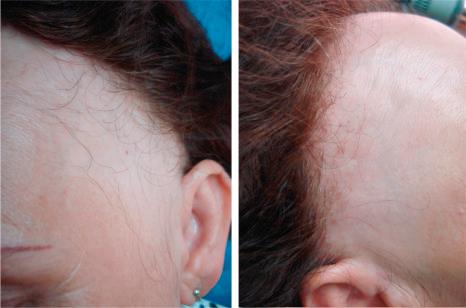
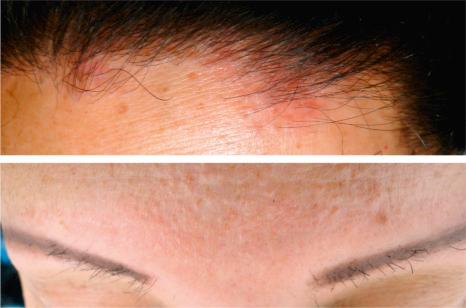
Progression is unpredictable, but the disease becomes stable in almost all patients. Clinically, the disease does not present with the multifocal areas of hair loss typically seen in lichen planus or pseudopélade of Brocq. There are usually no manifestations of lichen planus elsewhere although isolated cases have shown typical lichen planus in the skin or mucosae, particularly in pigmented lichen planus. In some patients, diffuse hair loss has been described.
Other cases have been associated with some components of Piccardi-Lassueur-Graham-Little syndrome, Sjögren syndrome, bilateral oophorectomy, hair repigmentation close to a patch of frontal fibrosing alopecia, hair transplantation for androgenetic alopecia, increased scalp sweating, and scalp vitiligo.
The pathogenesis of frontal fibrosing alopecia is unknown. Some cases of family groupings that share HLA-D have been observed, but it is not a consistent finding. The disease is considered a frontal variant of lichen planopilaris since the histologic findings are similar. Nevertheless, other studies have found differences in respect to the type of hair follicles affected, emphasizing the selective compromise of vellus-like and indeterminate hair follicles in this disease. Similar to lichen planopilaris, the histologic changes are not necessarily restricted to the scalp but may be observed on the eyebrows, face, and upper limbs even in asymptomatic patients.
The best biopsies to diagnose fibrous frontal alopecia are those that have been taken guided by dermoscopy and interpreted with horizontal sections. The histologic study shows a decrease in the number of hair follicles, which are replaced by fibrous tracts. There is a lymphocytic infiltrate in a lichenoid pattern, accompanied by perifollicular lamellar fibrosis ( Fig. 22.142 ). The disease in its initial state shows a tendency to simultaneously affect terminal, indeterminate, and vellus hair follicles in all phases of the cycle including telogen. As the disease progresses, the involvement is more restricted to terminal hair follicles. Sometimes, apoptosis is prominent ( Fig. 22.143 , see Fig. 22.135 ). The interfollicular epidermis is not involved. The immunofluorescence pattern is similar to that of other more conventional variants of lichen planus.
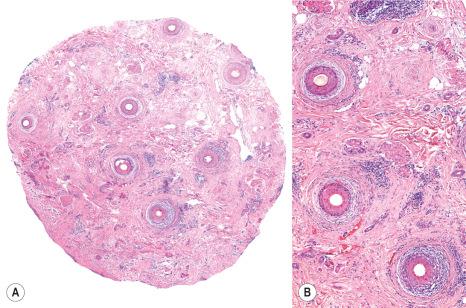

The differential diagnoses include female pattern hair loss, androgenetic alopecia, alopecia areata in a ‘sisaipho’ pattern (ophiasis inversus), and marginal traction alopecia.
Female pattern hair loss and androgenetic alopecia are not associated with perifollicular erythema, and female pattern hair loss is not related to frontal hair recession. In alopecia areata, a noninflammatory alopecic band with preservation of follicular orifices and presence of exclamation mark hairs is observed. Dermoscopy could be a helpful diagnostic tool as the yellow dots typically seen in alopecia areata are absent in frontal fibrosing alopecia. Histologically, in frontal fibrosing alopecia the infiltrate is found around the isthmus and in alopecia areata the infiltrate is seen around the peribulbar area. In cases of female pattern hair loss and androgenetic alopecia, the inflammatory infiltrate is minimal and the histologic picture is dominated by follicular miniaturization. Traction alopecia can be easily differentiated on the basis of physical examination and history of hair traction.
Finally, without adequate clinical information, distinction from conventional lichen planopilaris is not possible.
Fibrosing alopecia in a pattern distribution was described by Zinkernagel and Trüeb as a form of alopecia that shares similar characteristics with androgenic alopecia and lichen planopilaris. It affects both women and men. It is clinically characterized by progressive miniaturization of the hairs of the central scalp, perifollicular erythema, and follicular hyperkeratosis leading to complete loss of follicular ostia and scarring ( Fig. 22.144 ).
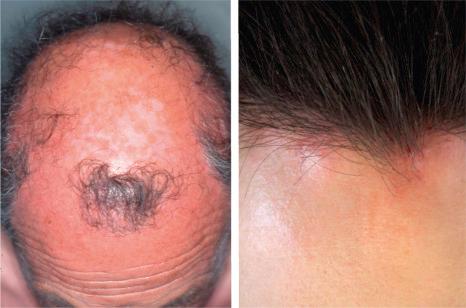
The pathogenesis of fibrosing alopecia in a pattern distribution is unknown. Histologic features consist of hair follicle miniaturization with a lymphocytic inflammatory cell infiltrate in the region of the isthmus and the infundibulum ( Fig. 22.145 ). Late lesions are characterized by perifollicular lamellar fibrosis and fibrous follicular tracts.
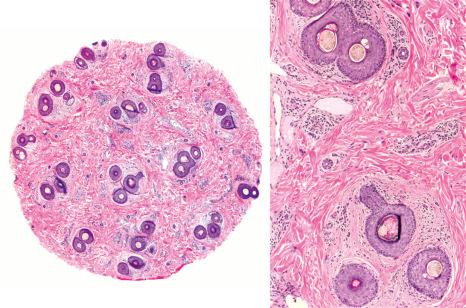
The differential diagnosis includes androgenetic alopecia, lichen planopilaris, and frontal fibrosing alopecia. Although in androgenetic alopecia a peri-infundibular lymphocytic inflammatory cell infiltrate may be seen (see Figs 22.17 and Fig. 22.46 ), this infiltrate does not concentrate around the isthmus and there is no apoptosis, loss of sebaceous glands, or lamellar fibrosis. Lichen planus is associated with all the latter features, but there is no involvement of vellus hairs by inflammation and there is a lack of miniaturization of hair follicles. In the initial stages of frontal fibrosing alopecia, there may be a predominant involvement of vellus hairs. In these cases, close clinicopathological correlation is necessary.
Become a Clinical Tree membership for Full access and enjoy Unlimited articles
If you are a member. Log in here